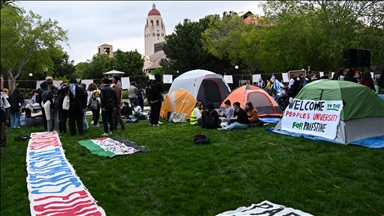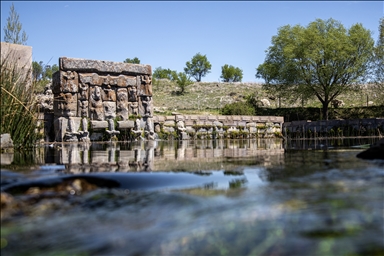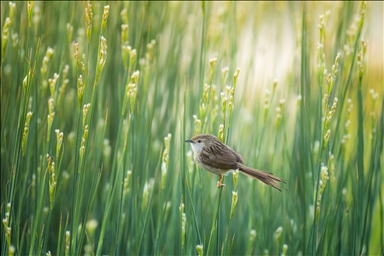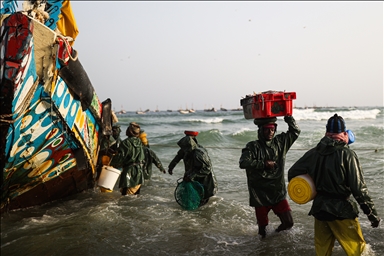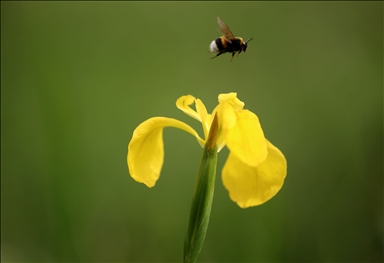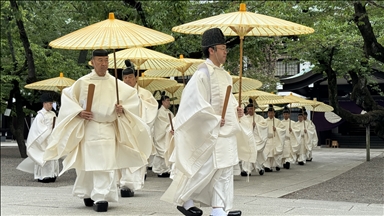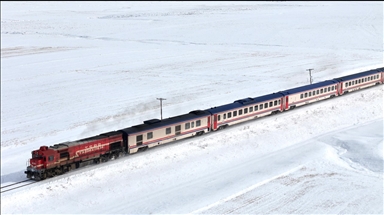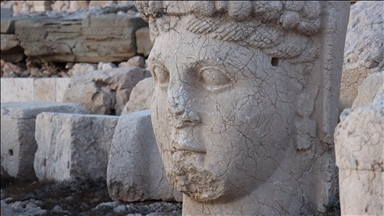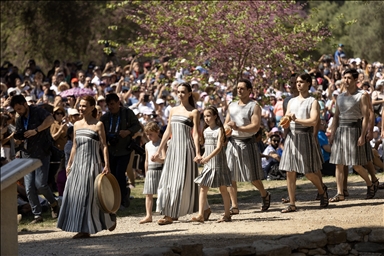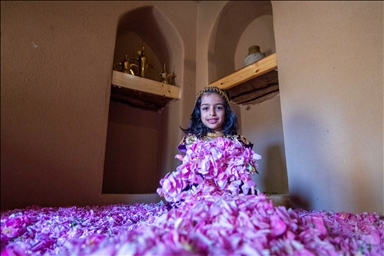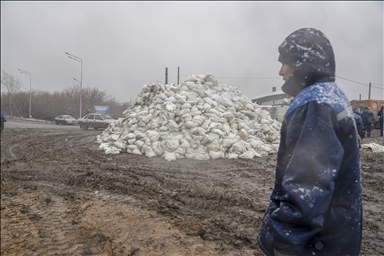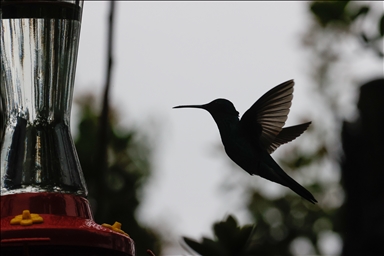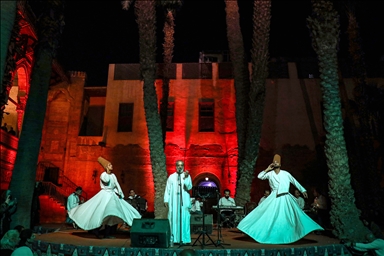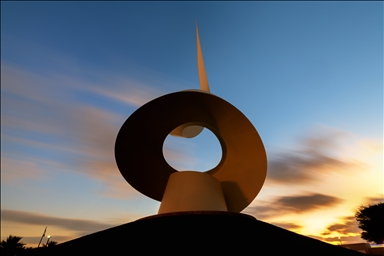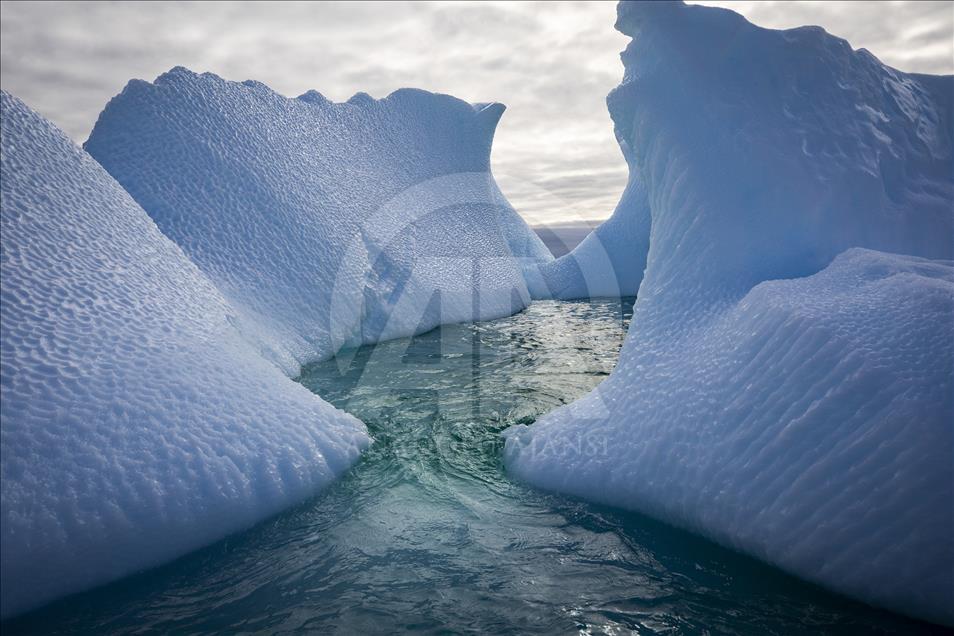
ANTARCTICA - FEBRUARY 09: Icebergs surround Galindez Island in Antarctica, on February 9, 2019. Turkey organized National Science Antarctica expedition for the 3rd time. Antarctica has been attracting scientific research teams and explorers with its challenging geography and nature throughout the history. Besides its attractiveness the continent is the world's coldest, most windy and arid place. For these reasons bases established here are allowed only for scientific research. The continent, which is not under the rule of any country, is called the continent of science and peace. 98 percent of the continent is covered almost entirely by ice that averages about a mile (1.6 kilometers) thick where 67 percent of the freshwater source on earth is found. During the winter season, sea ice fields covering about 18 million square kilometers, fall approximately 2 to 3 million square kilometer in the summer. The untouched nature of Antarctica is of great importance for the future of the world. The live water resources of the continent and the water potential in the glaciers are seen as the future water and food security of earth. Antarctica is the only continent on Earth without indigenous human inhabitants It only hosts various animals such as penguins, seals, whales and birds. The Antarctic Treaty, which was signed in 1959 when 53 countries were a party, allowed only bases with scientific studies and research to be active on the continent. There are about 100 scientific bases of 30 countries on the continent. ( Özge Elif Kızıl - Anadolu Agency )
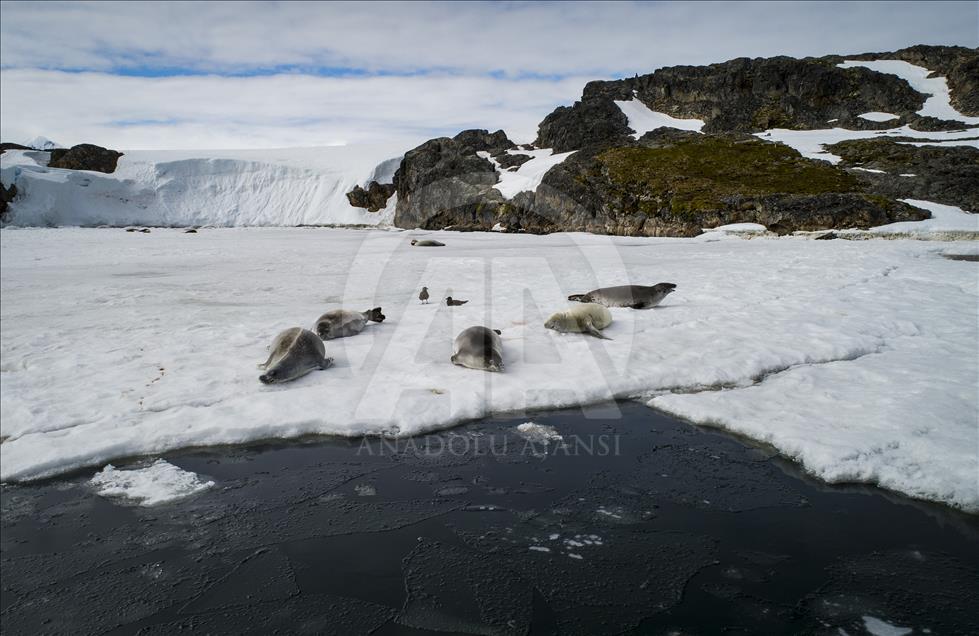
ANTARCTICA - FEBRUARY 09 : Crabeater seals are seen on Galindez Island, Antarctica on February 9, 2019. Turkey organized National Science Antarctica expedition for the 3rd time. Antarctica has been attracting scientific research teams and explorers with its challenging geography and nature throughout the history. Besides its attractiveness the continent is the world's coldest, most windy and arid place. For these reasons bases established here are allowed only for scientific research. The continent, which is not under the rule of any country, is called the continent of science and peace. 98 percent of the continent is covered almost entirely by ice that averages about a mile (1.6 kilometers) thick where 67 percent of the freshwater source on earth is found. During the winter season, sea ice fields covering about 18 million square kilometers, fall approximately 2 to 3 million square kilometer in the summer. The untouched nature of Antarctica is of great importance for the future of the world. The live water resources of the continent and the water potential in the glaciers are seen as the future water and food security of earth. Antarctica is the only continent on Earth without indigenous human inhabitants It only hosts various animals such as penguins, seals, whales and birds. The Antarctic Treaty, which was signed in 1959 when 53 countries were a party, allowed only bases with scientific studies and research to be active on the continent. There are about 100 scientific bases of 30 countries on the continent. ( Özge Elif Kızıl - Anadolu Agency )
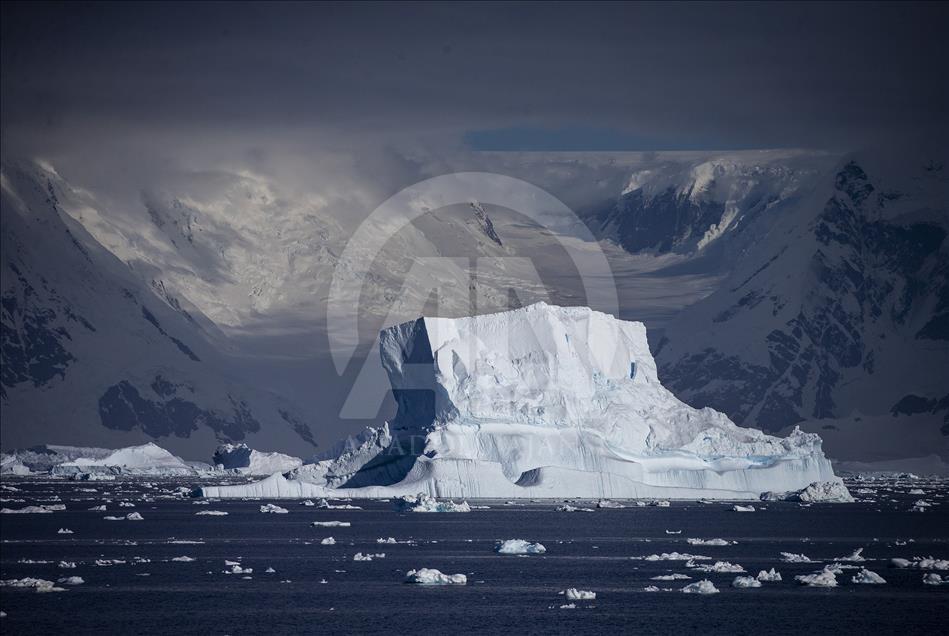
ANTARCTICA - FEBRUARY 09: Glaciers and icebergs surround Garlache Strait in Antarctica, on February 9, 2019. Turkey organized National Science Antarctica expedition for the 3rd time. Antarctica has been attracting scientific research teams and explorers with its challenging geography and nature throughout the history. Besides its attractiveness the continent is the world's coldest, most windy and arid place. For these reasons bases established here are allowed only for scientific research. The continent, which is not under the rule of any country, is called the continent of science and peace. 98 percent of the continent is covered almost entirely by ice that averages about a mile (1.6 kilometers) thick where 67 percent of the freshwater source on earth is found. During the winter season, sea ice fields covering about 18 million square kilometers, fall approximately 2 to 3 million square kilometer in the summer. The untouched nature of Antarctica is of great importance for the future of the world. The live water resources of the continent and the water potential in the glaciers are seen as the future water and food security of earth. Antarctica is the only continent on Earth without indigenous human inhabitants It only hosts various animals such as penguins, seals, whales and birds. The Antarctic Treaty, which was signed in 1959 when 53 countries were a party, allowed only bases with scientific studies and research to be active on the continent. There are about 100 scientific bases of 30 countries on the continent. ( Özge Elif Kızıl - Anadolu Agency )

ANTARCTICA - FEBRUARY 08: A view of Lemaire Channel, a strait off Antarctica, between Kiev Peninsula in the mainland's Graham Land and Booth Island, on February 8, 2019. Turkey organized National Science Antarctica expedition for the 3rd time. Antarctica has been attracting scientific research teams and explorers with its challenging geography and nature throughout the history. Besides its attractiveness the continent is the world's coldest, most windy and arid place. For these reasons bases established here are allowed only for scientific research. The continent, which is not under the rule of any country, is called the continent of science and peace. 98 percent of the continent is covered almost entirely by ice that averages about a mile (1.6 kilometers) thick where 67 percent of the freshwater source on earth is found. During the winter season, sea ice fields covering about 18 million square kilometers, fall approximately 2 to 3 million square kilometer in the summer. The untouched nature of Antarctica is of great importance for the future of the world. The live water resources of the continent and the water potential in the glaciers are seen as the future water and food security of earth. Antarctica is the only continent on Earth without indigenous human inhabitants It only hosts various animals such as penguins, seals, whales and birds. The Antarctic Treaty, which was signed in 1959 when 53 countries were a party, allowed only bases with scientific studies and research to be active on the continent. There are about 100 scientific bases of 30 countries on the continent. ( Özge Elif Kızıl - Anadolu Agency )
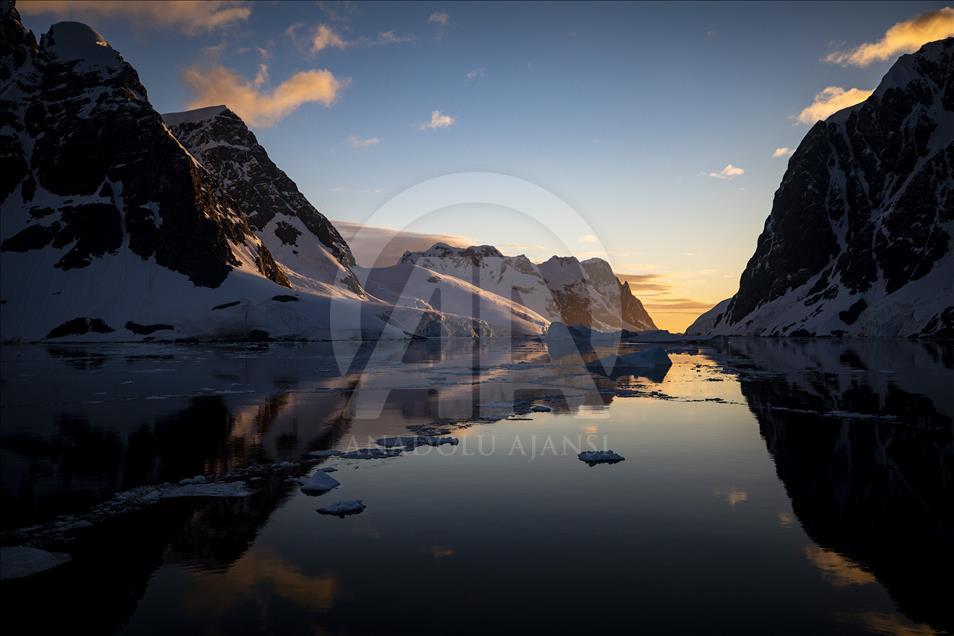
ANTARCTICA - FEBRUARY 08: Glaciers and cliffs are reflected in waters in Lemaire Channel, a strait off Antarctica, between Kiev Peninsula in the mainland's Graham Land and Booth Island, on February 8, 2019. Turkey organized National Science Antarctica expedition for the 3rd time. Antarctica has been attracting scientific research teams and explorers with its challenging geography and nature throughout the history. Besides its attractiveness the continent is the world's coldest, most windy and arid place. For these reasons bases established here are allowed only for scientific research. The continent, which is not under the rule of any country, is called the continent of science and peace. 98 percent of the continent is covered almost entirely by ice that averages about a mile (1.6 kilometers) thick where 67 percent of the freshwater source on earth is found. During the winter season, sea ice fields covering about 18 million square kilometers, fall approximately 2 to 3 million square kilometer in the summer. The untouched nature of Antarctica is of great importance for the future of the world. The live water resources of the continent and the water potential in the glaciers are seen as the future water and food security of earth. Antarctica is the only continent on Earth without indigenous human inhabitants It only hosts various animals such as penguins, seals, whales and birds. The Antarctic Treaty, which was signed in 1959 when 53 countries were a party, allowed only bases with scientific studies and research to be active on the continent. There are about 100 scientific bases of 30 countries on the continent. ( Özge Elif Kızıl - Anadolu Agency )

ANTARCTICA - FEBRUARY 08: A leopard seal rests on ice in Lemaire Channel, a strait off Antarctica, between Kiev Peninsula in the mainland's Graham Land and Booth Island, on February 8, 2019. Turkey organized National Science Antarctica expedition for the 3rd time. Antarctica has been attracting scientific research teams and explorers with its challenging geography and nature throughout the history. Besides its attractiveness the continent is the world's coldest, most windy and arid place. For these reasons bases established here are allowed only for scientific research. The continent, which is not under the rule of any country, is called the continent of science and peace. 98 percent of the continent is covered almost entirely by ice that averages about a mile (1.6 kilometers) thick where 67 percent of the freshwater source on earth is found. During the winter season, sea ice fields covering about 18 million square kilometers, fall approximately 2 to 3 million square kilometer in the summer. The untouched nature of Antarctica is of great importance for the future of the world. The live water resources of the continent and the water potential in the glaciers are seen as the future water and food security of earth. Antarctica is the only continent on Earth without indigenous human inhabitants It only hosts various animals such as penguins, seals, whales and birds. The Antarctic Treaty, which was signed in 1959 when 53 countries were a party, allowed only bases with scientific studies and research to be active on the continent. There are about 100 scientific bases of 30 countries on the continent. ( Özge Elif Kızıl - Anadolu Agency )

ANTARCTICA - FEBRUARY 08: An orca is watched in front of Gento penguins in Lemaire Channel, a strait off Antarctica, between Kiev Peninsula in the mainland's Graham Land and Booth Island, on February 8, 2019. Turkey organized National Science Antarctica expedition for the 3rd time. Antarctica has been attracting scientific research teams and explorers with its challenging geography and nature throughout the history. Besides its attractiveness the continent is the world's coldest, most windy and arid place. For these reasons bases established here are allowed only for scientific research. The continent, which is not under the rule of any country, is called the continent of science and peace. 98 percent of the continent is covered almost entirely by ice that averages about a mile (1.6 kilometers) thick where 67 percent of the freshwater source on earth is found. During the winter season, sea ice fields covering about 18 million square kilometers, fall approximately 2 to 3 million square kilometer in the summer. The untouched nature of Antarctica is of great importance for the future of the world. The live water resources of the continent and the water potential in the glaciers are seen as the future water and food security of earth. Antarctica is the only continent on Earth without indigenous human inhabitants It only hosts various animals such as penguins, seals, whales and birds. The Antarctic Treaty, which was signed in 1959 when 53 countries were a party, allowed only bases with scientific studies and research to be active on the continent. There are about 100 scientific bases of 30 countries on the continent. ( Özge Elif Kızıl - Anadolu Agency )
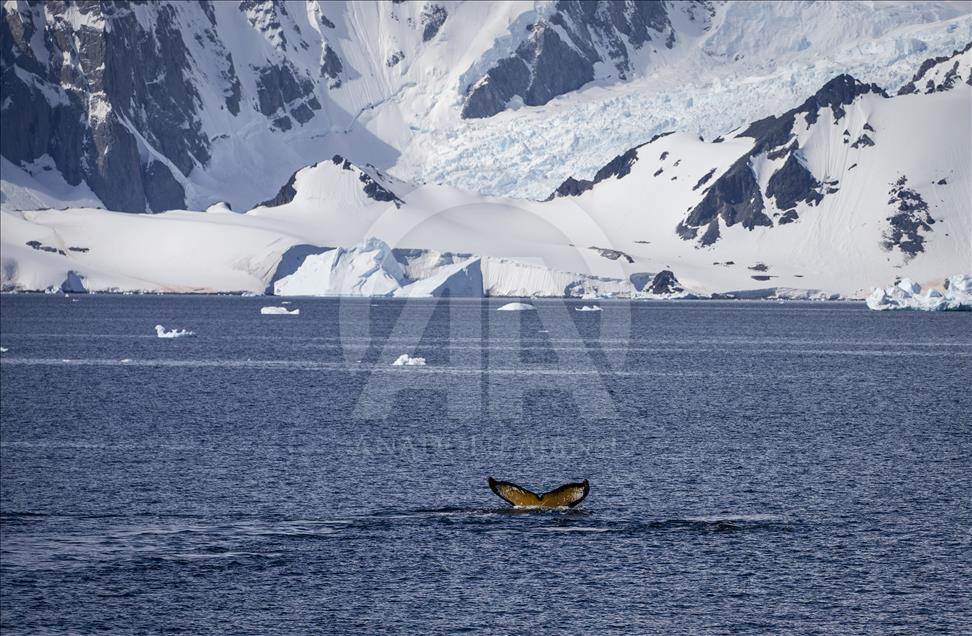
ANTARCTICA - FEBRUARY 09: A humpback whale is watched in Garlache Strait in Antarctica, on February 9, 2019. Turkey organized National Science Antarctica expedition for the 3rd time. Antarctica has been attracting scientific research teams and explorers with its challenging geography and nature throughout the history. Besides its attractiveness the continent is the world's coldest, most windy and arid place. For these reasons bases established here are allowed only for scientific research. The continent, which is not under the rule of any country, is called the continent of science and peace. 98 percent of the continent is covered almost entirely by ice that averages about a mile (1.6 kilometers) thick where 67 percent of the freshwater source on earth is found. During the winter season, sea ice fields covering about 18 million square kilometers, fall approximately 2 to 3 million square kilometer in the summer. The untouched nature of Antarctica is of great importance for the future of the world. The live water resources of the continent and the water potential in the glaciers are seen as the future water and food security of earth. Antarctica is the only continent on Earth without indigenous human inhabitants It only hosts various animals such as penguins, seals, whales and birds. The Antarctic Treaty, which was signed in 1959 when 53 countries were a party, allowed only bases with scientific studies and research to be active on the continent. There are about 100 scientific bases of 30 countries on the continent. ( Özge Elif Kızıl - Anadolu Agency )

ANTARCTICA - FEBRUARY 09: A humpback whale is watched on Garlache Strait in Antarctica, on February 9, 2019. Turkey organized National Science Antarctica expedition for the 3rd time. Antarctica has been attracting scientific research teams and explorers with its challenging geography and nature throughout the history. Besides its attractiveness the continent is the world's coldest, most windy and arid place. For these reasons bases established here are allowed only for scientific research. The continent, which is not under the rule of any country, is called the continent of science and peace. 98 percent of the continent is covered almost entirely by ice that averages about a mile (1.6 kilometers) thick where 67 percent of the freshwater source on earth is found. During the winter season, sea ice fields covering about 18 million square kilometers, fall approximately 2 to 3 million square kilometer in the summer. The untouched nature of Antarctica is of great importance for the future of the world. The live water resources of the continent and the water potential in the glaciers are seen as the future water and food security of earth. Antarctica is the only continent on Earth without indigenous human inhabitants It only hosts various animals such as penguins, seals, whales and birds. The Antarctic Treaty, which was signed in 1959 when 53 countries were a party, allowed only bases with scientific studies and research to be active on the continent. There are about 100 scientific bases of 30 countries on the continent. ( Özge Elif Kızıl - Anadolu Agency )
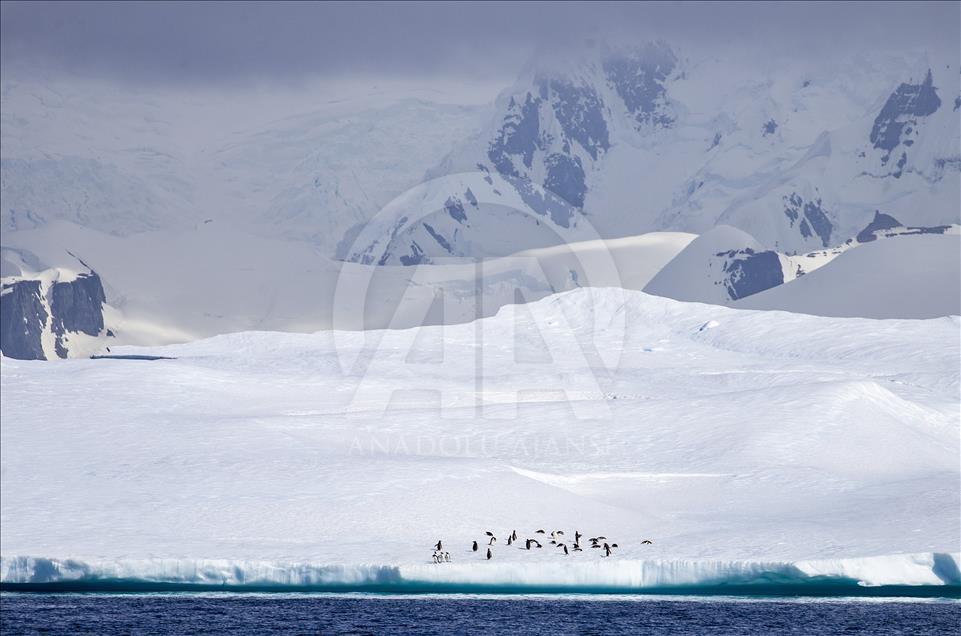
ANTARCTICA - FEBRUARY 09: Gento penguins are watched on ice floe on Garlache Strait in Antarctica, on February 9, 2019. Turkey organized National Science Antarctica expedition for the 3rd time. Antarctica has been attracting scientific research teams and explorers with its challenging geography and nature throughout the history. Besides its attractiveness the continent is the world's coldest, most windy and arid place. For these reasons bases established here are allowed only for scientific research. The continent, which is not under the rule of any country, is called the continent of science and peace. 98 percent of the continent is covered almost entirely by ice that averages about a mile (1.6 kilometers) thick where 67 percent of the freshwater source on earth is found. During the winter season, sea ice fields covering about 18 million square kilometers, fall approximately 2 to 3 million square kilometer in the summer. The untouched nature of Antarctica is of great importance for the future of the world. The live water resources of the continent and the water potential in the glaciers are seen as the future water and food security of earth. Antarctica is the only continent on Earth without indigenous human inhabitants It only hosts various animals such as penguins, seals, whales and birds. The Antarctic Treaty, which was signed in 1959 when 53 countries were a party, allowed only bases with scientific studies and research to be active on the continent. There are about 100 scientific bases of 30 countries on the continent. ( Özge Elif Kızıl - Anadolu Agency )
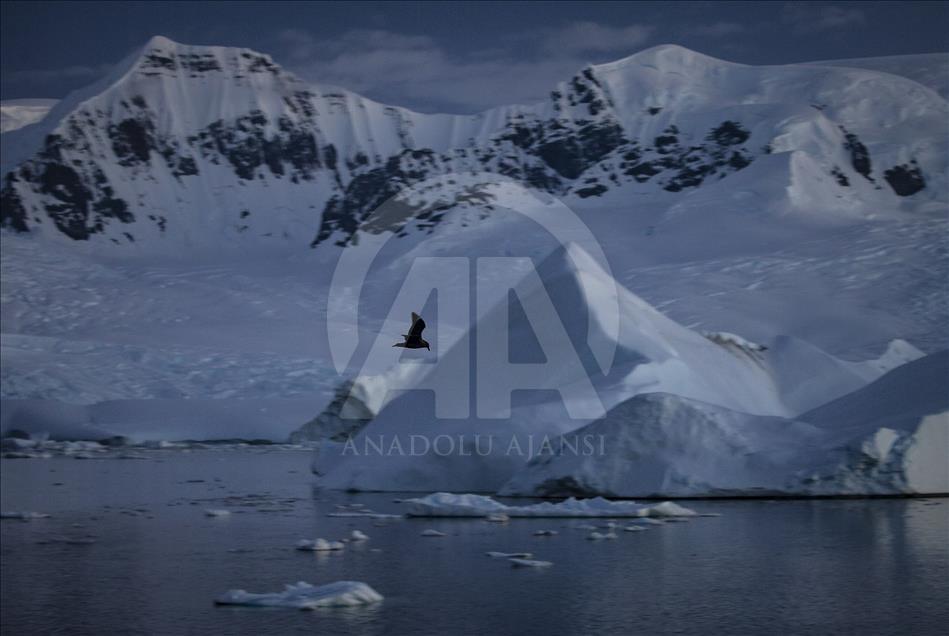
ANTARCTICA - FEBRUARY 08: Glaciers surround Lemaire Channel, a strait off Antarctica, between Kiev Peninsula in the mainland's Graham Land and Booth Island, on February 8, 2019. Turkey organized National Science Antarctica expedition for the 3rd time. Antarctica has been attracting scientific research teams and explorers with its challenging geography and nature throughout the history. Besides its attractiveness the continent is the world's coldest, most windy and arid place. For these reasons bases established here are allowed only for scientific research. The continent, which is not under the rule of any country, is called the continent of science and peace. 98 percent of the continent is covered almost entirely by ice that averages about a mile (1.6 kilometers) thick where 67 percent of the freshwater source on earth is found. During the winter season, sea ice fields covering about 18 million square kilometers, fall approximately 2 to 3 million square kilometer in the summer. The untouched nature of Antarctica is of great importance for the future of the world. The live water resources of the continent and the water potential in the glaciers are seen as the future water and food security of earth. Antarctica is the only continent on Earth without indigenous human inhabitants It only hosts various animals such as penguins, seals, whales and birds. The Antarctic Treaty, which was signed in 1959 when 53 countries were a party, allowed only bases with scientific studies and research to be active on the continent. There are about 100 scientific bases of 30 countries on the continent. ( Özge Elif Kızıl - Anadolu Agency )
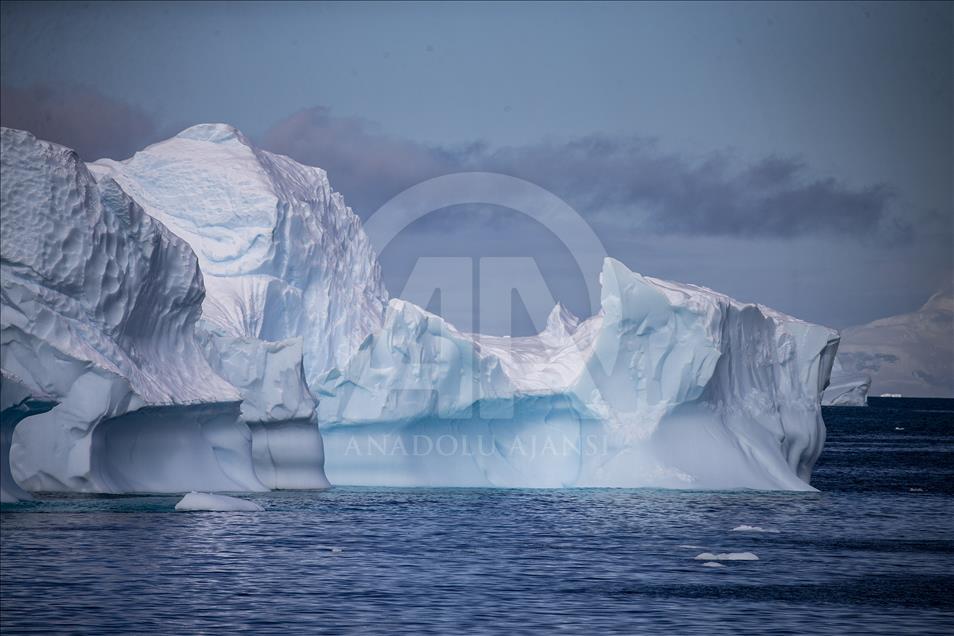
ANTARCTICA - FEBRUARY 09: Glaciers surround Garlache Strait in Antarctica, on February 9, 2019. Turkey organized National Science Antarctica expedition for the 3rd time. Antarctica has been attracting scientific research teams and explorers with its challenging geography and nature throughout the history. Besides its attractiveness the continent is the world's coldest, most windy and arid place. For these reasons bases established here are allowed only for scientific research. The continent, which is not under the rule of any country, is called the continent of science and peace. 98 percent of the continent is covered almost entirely by ice that averages about a mile (1.6 kilometers) thick where 67 percent of the freshwater source on earth is found. During the winter season, sea ice fields covering about 18 million square kilometers, fall approximately 2 to 3 million square kilometer in the summer. The untouched nature of Antarctica is of great importance for the future of the world. The live water resources of the continent and the water potential in the glaciers are seen as the future water and food security of earth. Antarctica is the only continent on Earth without indigenous human inhabitants It only hosts various animals such as penguins, seals, whales and birds. The Antarctic Treaty, which was signed in 1959 when 53 countries were a party, allowed only bases with scientific studies and research to be active on the continent. There are about 100 scientific bases of 30 countries on the continent. ( Özge Elif Kızıl - Anadolu Agency )

ANTARCTICA - FEBRUARY 09: Icebergs and ice floes surrounds Garlache Strait in Antarctica, on February 9, 2019. Turkey organized National Science Antarctica expedition for the 3rd time. Antarctica has been attracting scientific research teams and explorers with its challenging geography and nature throughout the history. Besides its attractiveness the continent is the world's coldest, most windy and arid place. For these reasons bases established here are allowed only for scientific research. The continent, which is not under the rule of any country, is called the continent of science and peace. 98 percent of the continent is covered almost entirely by ice that averages about a mile (1.6 kilometers) thick where 67 percent of the freshwater source on earth is found. During the winter season, sea ice fields covering about 18 million square kilometers, fall approximately 2 to 3 million square kilometer in the summer. The untouched nature of Antarctica is of great importance for the future of the world. The live water resources of the continent and the water potential in the glaciers are seen as the future water and food security of earth. Antarctica is the only continent on Earth without indigenous human inhabitants It only hosts various animals such as penguins, seals, whales and birds. The Antarctic Treaty, which was signed in 1959 when 53 countries were a party, allowed only bases with scientific studies and research to be active on the continent. There are about 100 scientific bases of 30 countries on the continent. ( Özge Elif Kızıl - Anadolu Agency )
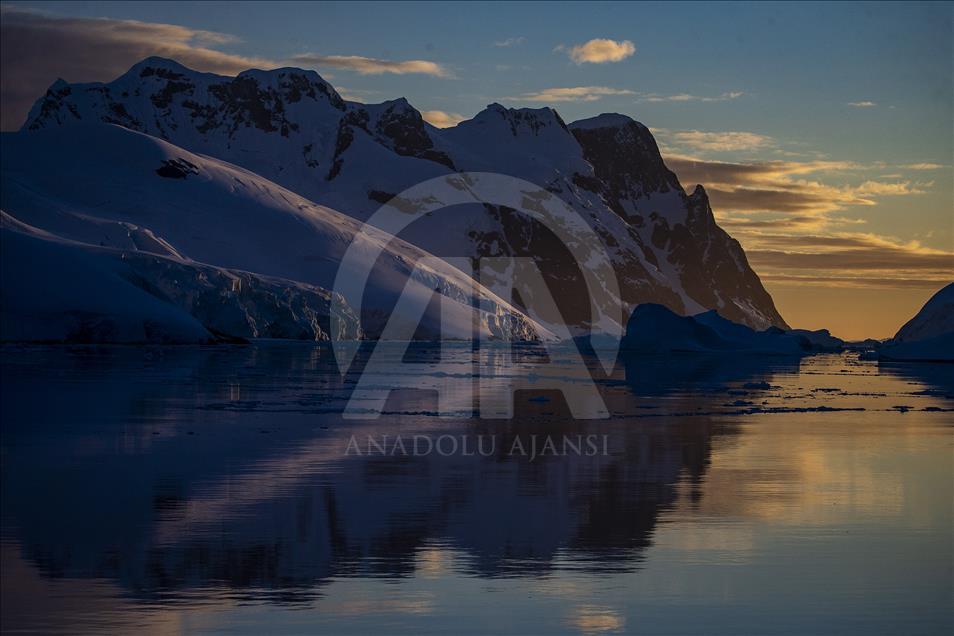
ANTARCTICA - FEBRUARY 08: Glaciers and cliffs are reflected in waters in Lemaire Channel, a strait off Antarctica, between Kiev Peninsula in the mainland's Graham Land and Booth Island, on February 8, 2019. Turkey organized National Science Antarctica expedition for the 3rd time. Antarctica have been attracting scientific research teams and explorers with its challenging geography and nature throughout the history. Besides its attractiveness the continent is the world's coldest, most windy and arid place. For these reasons bases established here are allowed only for scientific research. The continent, which is not under the rule of any country, is called the continent of science and peace. 98 percent of the continent is covered almost entirely by ice that averages about a mile (1.6 kilometers) thick where 67 percent of the freshwater source on earth is found. During the winter season, sea ice fields covering about 18 million square kilometers, fall approximately 2 to 3 million square kilometer in the summer. The untouched nature of Antarctica is of great importance for the future of the world. The live water resources of the continent and the water potential in the glaciers are seen as the future water and food security of earth. Antarctica is the only continent on Earth without indigenous human inhabitants It only hosts various animals such as penguins, seals, whales and birds. The Antarctic Treaty, which was signed in 1959 when 53 countries were a party, allowed only bases with scientific studies and research to be active on the continent. There are about 100 scientific bases of 30 countries on the continent. ( Özge Elif Kızıl - Anadolu Agency )

ANTARCTICA - FEBRUARY 09: Icebergs and ice floes surround Garlache Strait in Antarctica, on February 9, 2019. Turkey organized National Science Antarctica expedition for the 3rd time. Antarctica has been attracting scientific research teams and explorers with its challenging geography and nature throughout the history. Besides its attractiveness the continent is the world's coldest, most windy and arid place. For these reasons bases established here are allowed only for scientific research. The continent, which is not under the rule of any country, is called the continent of science and peace. 98 percent of the continent is covered almost entirely by ice that averages about a mile (1.6 kilometers) thick where 67 percent of the freshwater source on earth is found. During the winter season, sea ice fields covering about 18 million square kilometers, fall approximately 2 to 3 million square kilometer in the summer. The untouched nature of Antarctica is of great importance for the future of the world. The live water resources of the continent and the water potential in the glaciers are seen as the future water and food security of earth. Antarctica is the only continent on Earth without indigenous human inhabitants It only hosts various animals such as penguins, seals, whales and birds. The Antarctic Treaty, which was signed in 1959 when 53 countries were a party, allowed only bases with scientific studies and research to be active on the continent. There are about 100 scientific bases of 30 countries on the continent. ( Özge Elif Kızıl - Anadolu Agency )
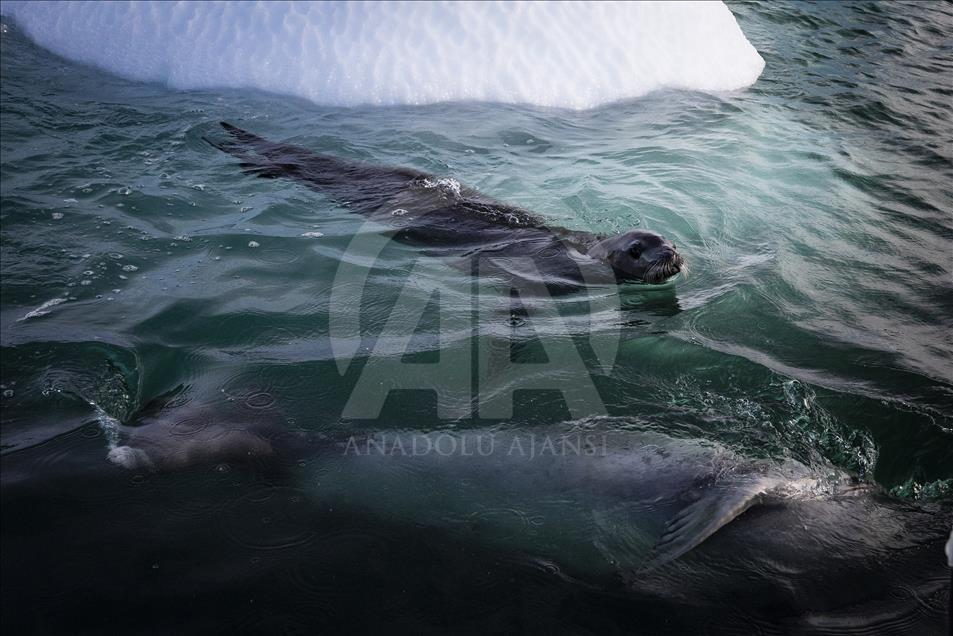
ANTARCTICA - FEBRUARY 09 : A Crabeater seal swims on Galindez Island, Antarctica on February 9, 2019. Turkey organized National Science Antarctica expedition for the 3rd time. Antarctica have has attracting scientific research teams and explorers with its challenging geography and nature throughout the history. Besides its attractiveness the continent is the world's coldest, most windy and arid place. For these reasons bases established here are allowed only for scientific research. The continent, which is not under the rule of any country, is called the continent of science and peace. 98 percent of the continent is covered almost entirely by ice that averages about a mile (1.6 kilometers) thick where 67 percent of the freshwater source on earth is found. During the winter season, sea ice fields covering about 18 million square kilometers, fall approximately 2 to 3 million square kilometer in the summer. The untouched nature of Antarctica is of great importance for the future of the world. The live water resources of the continent and the water potential in the glaciers are seen as the future water and food security of earth. Antarctica is the only continent on Earth without indigenous human inhabitants It only hosts various animals such as penguins, seals, whales and birds. The Antarctic Treaty, which was signed in 1959 when 53 countries were a party, allowed only bases with scientific studies and research to be active on the continent. There are about 100 scientific bases of 30 countries on the continent. ( Özge Elif Kızıl - Anadolu Agency )

ANTARCTICA - FEBRUARY 09 : Ukrainian scientific research team members return to Vernadsky Research Base, a Ukrainian Antarctic Station after a research at Marina Point on Galindez Island, Antarctica, on February 09, 2019. Turkey organized National Science Antarctica Expedition for the 3rd time. Antarctica has been attracting scientific research teams and explorers with its challenging geography and nature throughout the history. Besides its attractiveness the continent is the world's coldest, most windy and arid place. For these reasons bases established here are allowed only for scientific research. The continent, which is not under the rule of any country, is called the continent of science and peace. 98 percent of the continent is covered almost entirely by ice that averages about a mile (1.6 kilometers) thick where 67 percent of the freshwater source on earth is found. During the winter season, sea ice fields covering about 18 million square kilometers, fall approximately 2 to 3 million square kilometer in the summer. The untouched nature of Antarctica is of great importance for the future of the world. The live water resources of the continent and the water potential in the glaciers are seen as the future water and food security of earth. Antarctica is the only continent on Earth without indigenous human inhabitants It only hosts various animals such as penguins, seals, whales and birds. The Antarctic Treaty, which was signed in 1959 when 53 countries were a party, allowed only bases with scientific studies and research to be active on the continent. There are about 100 scientific bases of 30 countries on the continent. ( Özge Elif Kızıl - Anadolu Agency )
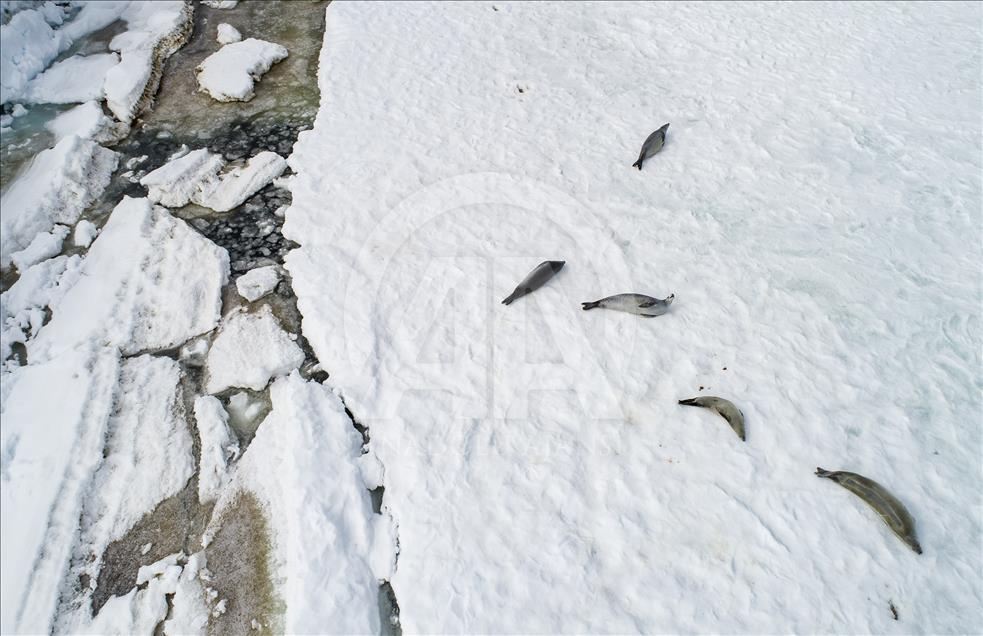
ANTARCTICA - FEBRUARY 09 : An aerial view of Crabeater seals are seen on Galindez Island, Antarctica on February 9, 2019. Turkey organized National Science Antarctica expedition for the 3rd time. Antarctica has been attracting scientific research teams and explorers with its challenging geography and nature throughout the history. Besides its attractiveness the continent is the world's coldest, most windy and arid place. For these reasons bases established here are allowed only for scientific research. The continent, which is not under the rule of any country, is called the continent of science and peace. 98 percent of the continent is covered almost entirely by ice that averages about a mile (1.6 kilometers) thick where 67 percent of the freshwater source on earth is found. During the winter season, sea ice fields covering about 18 million square kilometers, fall approximately 2 to 3 million square kilometer in the summer. The untouched nature of Antarctica is of great importance for the future of the world. The live water resources of the continent and the water potential in the glaciers are seen as the future water and food security of earth. Antarctica is the only continent on Earth without indigenous human inhabitants It only hosts various animals such as penguins, seals, whales and birds. The Antarctic Treaty, which was signed in 1959 when 53 countries were a party, allowed only bases with scientific studies and research to be active on the continent. There are about 100 scientific bases of 30 countries on the continent. ( Özge Elif Kızıl - Anadolu Agency )
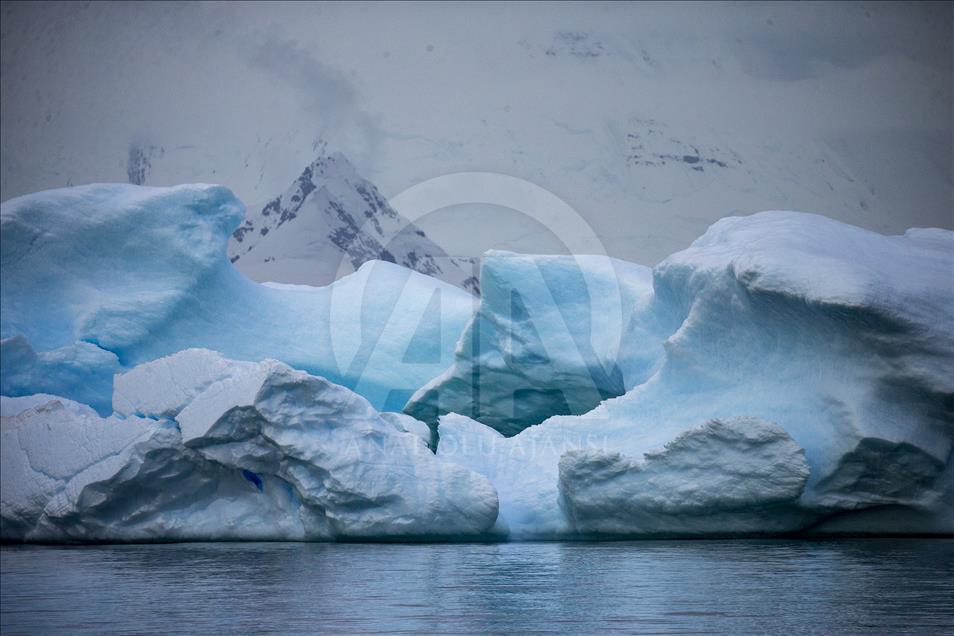
ANTARCTICA - FEBRUARY 09: Glaciers surround Garlache Strait in Antarctica, on February 9, 2019. Turkey organized National Science Antarctica expedition for the 3rd time. Antarctica has been attracting scientific research teams and explorers with its challenging geography and nature throughout the history. Besides its attractiveness the continent is the world's coldest, most windy and arid place. For these reasons bases established here are allowed only for scientific research. The continent, which is not under the rule of any country, is called the continent of science and peace. 98 percent of the continent is covered almost entirely by ice that averages about a mile (1.6 kilometers) thick where 67 percent of the freshwater source on earth is found. During the winter season, sea ice fields covering about 18 million square kilometers, fall approximately 2 to 3 million square kilometer in the summer. The untouched nature of Antarctica is of great importance for the future of the world. The live water resources of the continent and the water potential in the glaciers are seen as the future water and food security of earth. Antarctica is the only continent on Earth without indigenous human inhabitants It only hosts various animals such as penguins, seals, whales and birds. The Antarctic Treaty, which was signed in 1959 when 53 countries were a party, allowed only bases with scientific studies and research to be active on the continent. There are about 100 scientific bases of 30 countries on the continent. ( Özge Elif Kızıl - Anadolu Agency )
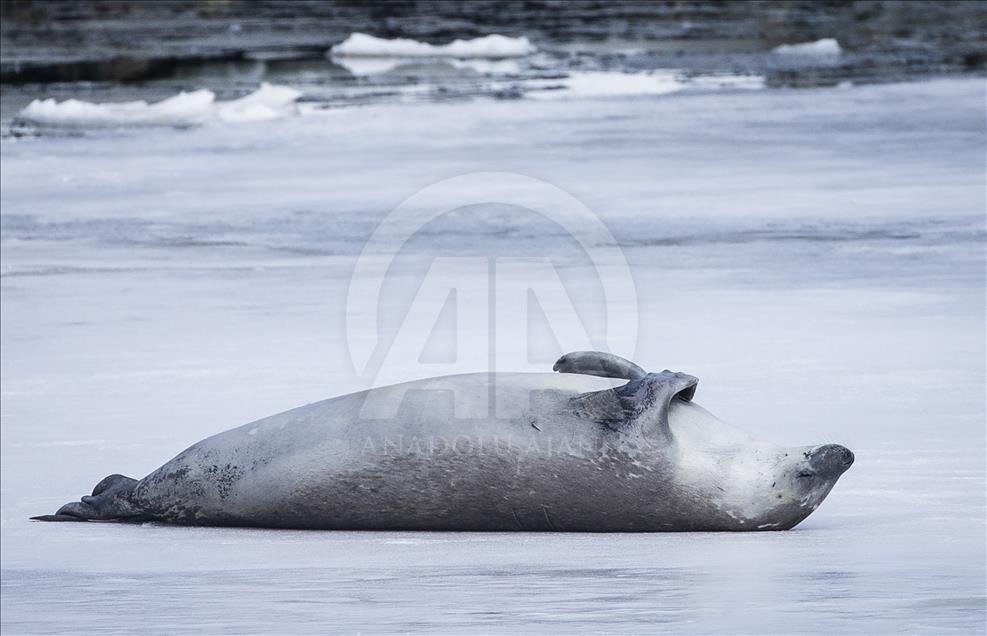
ANTARCTICA - FEBRUARY 09 : A Crabeater seal is seen on Galindez Island, Antarctica on February 9, 2019. Turkey organized National Science Antarctica expedition for the 3rd time. Antarctica has been attracting scientific research teams and explorers with its challenging geography and nature throughout the history. Besides its attractiveness the continent is the world's coldest, most windy and arid place. For these reasons bases established here are allowed only for scientific research. The continent, which is not under the rule of any country, is called the continent of science and peace. 98 percent of the continent is covered almost entirely by ice that averages about a mile (1.6 kilometers) thick where 67 percent of the freshwater source on earth is found. During the winter season, sea ice fields covering about 18 million square kilometers, fall approximately 2 to 3 million square kilometer in the summer. The untouched nature of Antarctica is of great importance for the future of the world. The live water resources of the continent and the water potential in the glaciers are seen as the future water and food security of earth. Antarctica is the only continent on Earth without indigenous human inhabitants It only hosts various animals such as penguins, seals, whales and birds. The Antarctic Treaty, which was signed in 1959 when 53 countries were a party, allowed only bases with scientific studies and research to be active on the continent. There are about 100 scientific bases of 30 countries on the continent. ( Özge Elif Kızıl - Anadolu Agency )
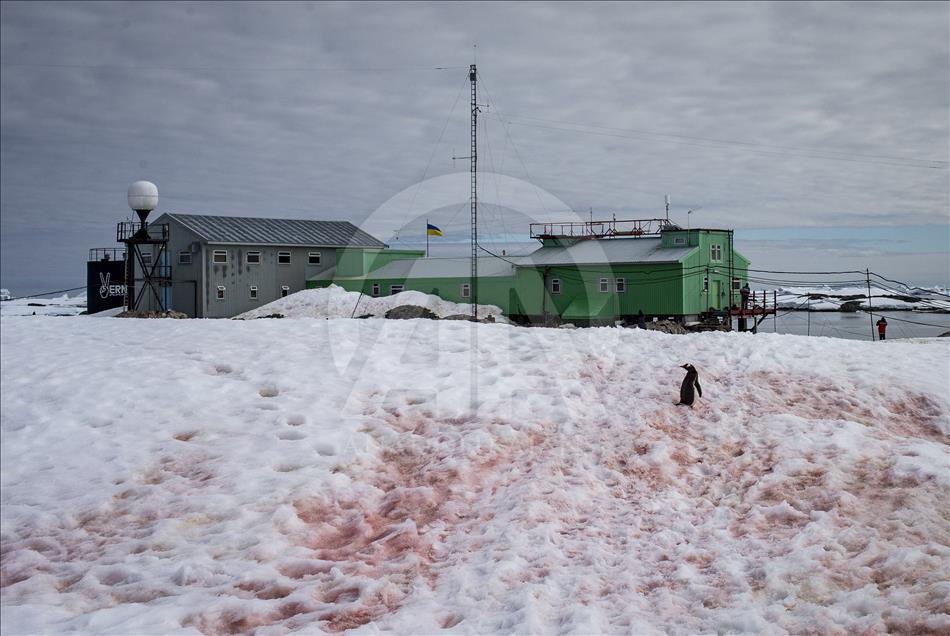
ANTARCTICA - FEBRUARY 09 : A Gentoo penguin walks on a snow covered field near Vernadsky Research Base, a Ukrainian Antarctic Station at Marina Point on Galindez Island, Antarctica, on February 09, 2019. Turkey organized National Science Antarctica Expedition for the 3rd time. Antarctica has been attracting scientific research teams and explorers with its challenging geography and nature throughout the history. Besides its attractiveness the continent is the world's coldest, most windy and arid place. For these reasons bases established here are allowed only for scientific research. The continent, which is not under the rule of any country, is called the continent of science and peace. 98 percent of the continent is covered almost entirely by ice that averages about a mile (1.6 kilometers) thick where 67 percent of the freshwater source on earth is found. During the winter season, sea ice fields covering about 18 million square kilometers, fall approximately 2 to 3 million square kilometer in the summer. The untouched nature of Antarctica is of great importance for the future of the world. The live water resources of the continent and the water potential in the glaciers are seen as the future water and food security of earth. Antarctica is the only continent on Earth without indigenous human inhabitants It only hosts various animals such as penguins, seals, whales and birds. The Antarctic Treaty, which was signed in 1959 when 53 countries were a party, allowed only bases with scientific studies and research to be active on the continent. There are about 100 scientific bases of 30 countries on the continent. ( Özge Elif Kızıl - Anadolu Agency )
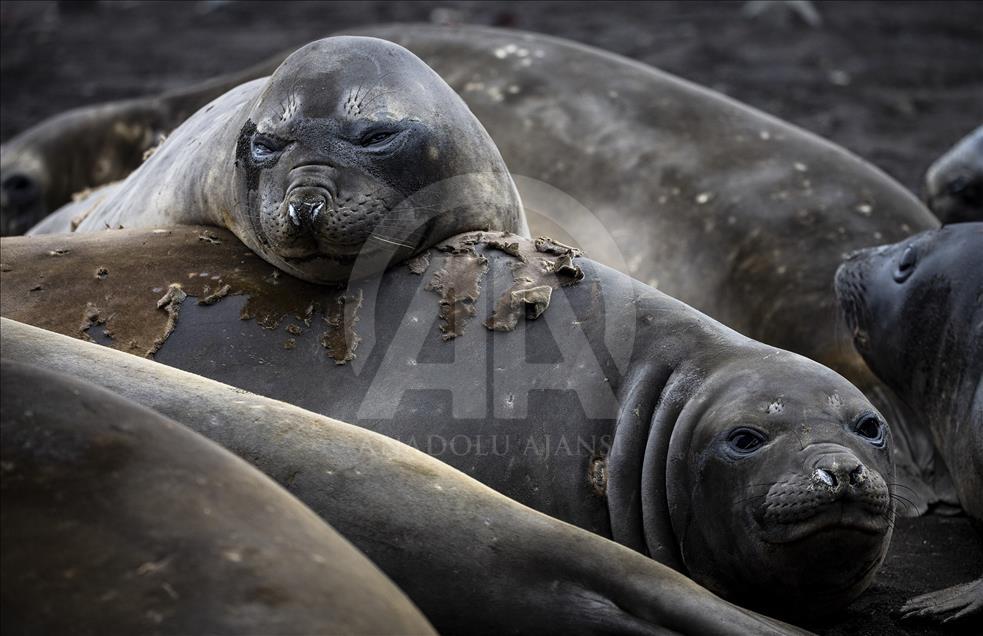
ANTARCTICA - FEBRUARY 06 : Elephant seals, the largest species of seal family are seen on King George Island, Antarctica on February 6, 2019. Turkey organized National Science Antarctica expedition for the 3rd time. Antarctica has been attracting scientific research teams and explorers with its challenging geography and nature throughout the history. Besides its attractiveness the continent is the world's coldest, most windy and arid place. For these reasons bases established here are allowed only for scientific research. The continent, which is not under the rule of any country, is called the continent of science and peace. 98 percent of the continent is covered almost entirely by ice that averages about a mile (1.6 kilometers) thick where 67 percent of the freshwater source on earth is found. During the winter season, sea ice fields covering about 18 million square kilometers, fall approximately 2 to 3 million square kilometer in the summer. The untouched nature of Antarctica is of great importance for the future of the world. The live water resources of the continent and the water potential in the glaciers are seen as the future water and food security of earth. Antarctica is the only continent on Earth without indigenous human inhabitants It only hosts various animals such as penguins, seals, whales and birds. The Antarctic Treaty, which was signed in 1959 when 53 countries were a party, allowed only bases with scientific studies and research to be active on the continent. There are about 100 scientific bases of 30 countries on the continent. ( Özge Elif Kızıl - Anadolu Agency )
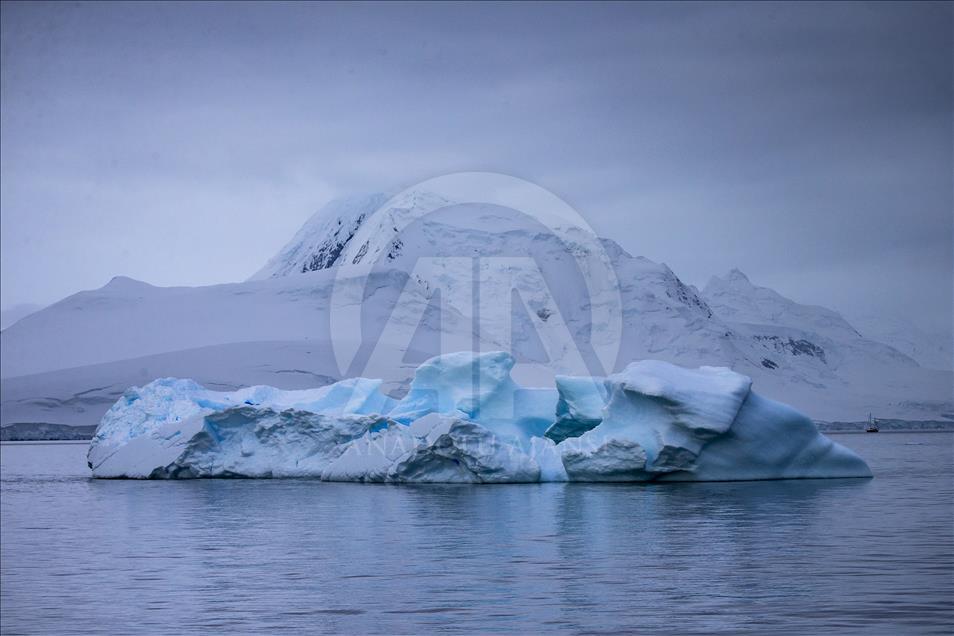
ANTARCTICA - FEBRUARY 09: Glaciers and ice floes surround Garlache Strait in Antarctica, on February 9, 2019. Turkey organized National Science Antarctica expedition for the 3rd time. Antarctica has been attracting scientific research teams and explorers with its challenging geography and nature throughout the history. Besides its attractiveness the continent is the world's coldest, most windy and arid place. For these reasons bases established here are allowed only for scientific research. The continent, which is not under the rule of any country, is called the continent of science and peace. 98 percent of the continent is covered almost entirely by ice that averages about a mile (1.6 kilometers) thick where 67 percent of the freshwater source on earth is found. During the winter season, sea ice fields covering about 18 million square kilometers, fall approximately 2 to 3 million square kilometer in the summer. The untouched nature of Antarctica is of great importance for the future of the world. The live water resources of the continent and the water potential in the glaciers are seen as the future water and food security of earth. Antarctica is the only continent on Earth without indigenous human inhabitants It only hosts various animals such as penguins, seals, whales and birds. The Antarctic Treaty, which was signed in 1959 when 53 countries were a party, allowed only bases with scientific studies and research to be active on the continent. There are about 100 scientific bases of 30 countries on the continent. ( Özge Elif Kızıl - Anadolu Agency )
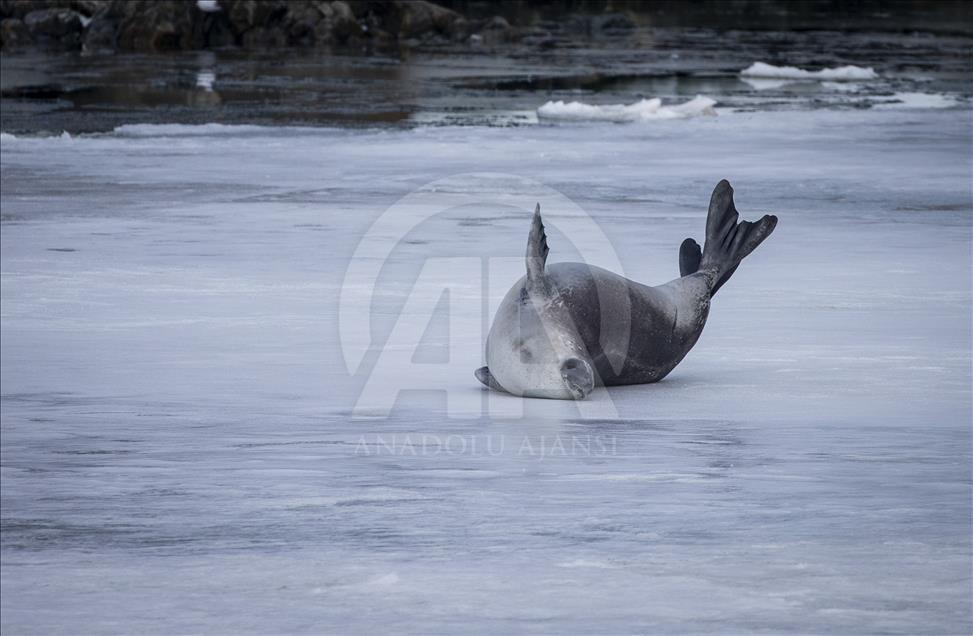
ANTARCTICA - FEBRUARY 09 : A Crabeater seal is seen on Galindez Island, Antarctica on February 9, 2019. Turkey organized National Science Antarctica expedition for the 3rd time. Antarctica have been attracting scientific research teams and explorers with its challenging geography and nature throughout the history. Besides its attractiveness the continent is the world's coldest, most windy and arid place. For these reasons bases established here are allowed only for scientific research. The continent, which is not under the rule of any country, is called the continent of science and peace. 98 percent of the continent is covered almost entirely by ice that averages about a mile (1.6 kilometers) thick where 67 percent of the freshwater source on earth is found. During the winter season, sea ice fields covering about 18 million square kilometers, fall approximately 2 to 3 million square kilometer in the summer. The untouched nature of Antarctica is of great importance for the future of the world. The live water resources of the continent and the water potential in the glaciers are seen as the future water and food security of earth. Antarctica is the only continent on Earth without indigenous human inhabitants It only hosts various animals such as penguins, seals, whales and birds. The Antarctic Treaty, which was signed in 1959 when 53 countries were a party, allowed only bases with scientific studies and research to be active on the continent. There are about 100 scientific bases of 30 countries on the continent. ( Özge Elif Kızıl - Anadolu Agency )
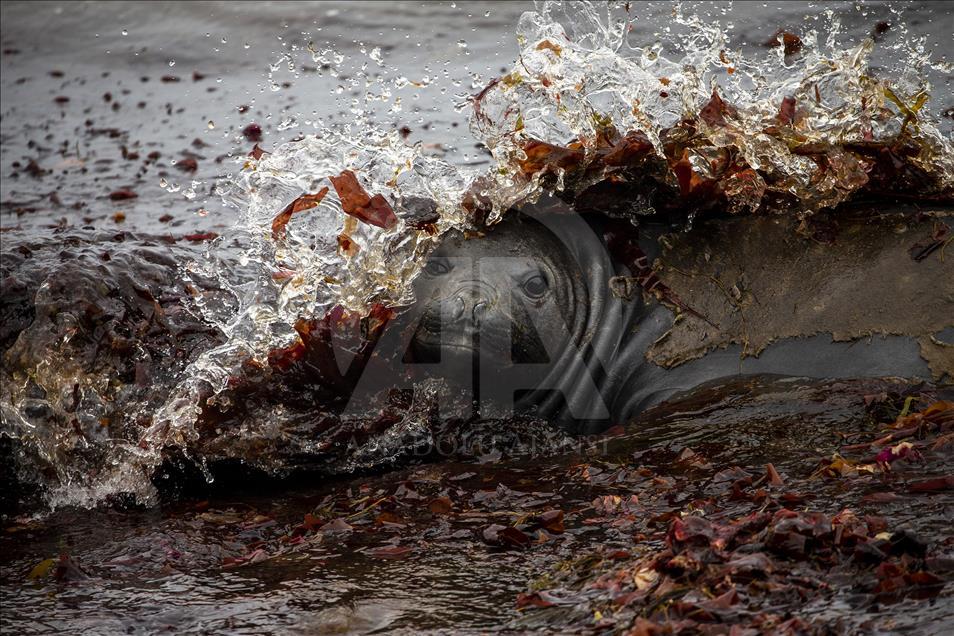
ANTARCTICA - FEBRUARY 06 : An Elephant seal, the largest species of seal family is seen on King George Island, Antarctica on February 6, 2019. Turkey organized National Science Antarctica expedition for the 3rd time. Antarctica has been attracting scientific research teams and explorers with its challenging geography and nature throughout the history. Besides its attractiveness the continent is the world's coldest, most windy and arid place. For these reasons bases established here are allowed only for scientific research. The continent, which is not under the rule of any country, is called the continent of science and peace. 98 percent of the continent is covered almost entirely by ice that averages about a mile (1.6 kilometers) thick where 67 percent of the freshwater source on earth is found. During the winter season, sea ice fields covering about 18 million square kilometers, fall approximately 2 to 3 million square kilometer in the summer. The untouched nature of Antarctica is of great importance for the future of the world. The live water resources of the continent and the water potential in the glaciers are seen as the future water and food security of earth. Antarctica is the only continent on Earth without indigenous human inhabitants It only hosts various animals such as penguins, seals, whales and birds. The Antarctic Treaty, which was signed in 1959 when 53 countries were a party, allowed only bases with scientific studies and research to be active on the continent. There are about 100 scientific bases of 30 countries on the continent. ( Özge Elif Kızıl - Anadolu Agency )

ANTARCTICA - FEBRUARY 08: Crabeater seals lay on ice floes in Lemaire Channel, a strait off Antarctica, between Kiev Peninsula in the mainland's Graham Land and Booth Island, on February 8, 2019. Turkey organized National Science Antarctica expedition for the 3rd time. Antarctica has been attracting scientific research teams and explorers with its challenging geography and nature throughout the history. Besides its attractiveness the continent is the world's coldest, most windy and arid place. For these reasons bases established here are allowed only for scientific research. The continent, which is not under the rule of any country, is called the continent of science and peace. 98 percent of the continent is covered almost entirely by ice that averages about a mile (1.6 kilometers) thick where 67 percent of the freshwater source on earth is found. During the winter season, sea ice fields covering about 18 million square kilometers, fall approximately 2 to 3 million square kilometer in the summer. The untouched nature of Antarctica is of great importance for the future of the world. The live water resources of the continent and the water potential in the glaciers are seen as the future water and food security of earth. Antarctica is the only continent on Earth without indigenous human inhabitants It only hosts various animals such as penguins, seals, whales and birds. The Antarctic Treaty, which was signed in 1959 when 53 countries were a party, allowed only bases with scientific studies and research to be active on the continent. There are about 100 scientific bases of 30 countries on the continent. ( Özge Elif Kızıl - Anadolu Agency )

ANTARCTICA - FEBRUARY 09 : Ukrainian scientific research team members set up an observation pole at Vernadsky Research Base, a Ukrainian Antarctic Station at Marina Point on Galindez Island, Antarctica, on February 09, 2019. Turkey organized National Science Antarctica Expedition for the 3rd time. Antarctica has been attracting scientific research teams and explorers with its challenging geography and nature throughout the history. Besides its attractiveness the continent is the world's coldest, most windy and arid place. For these reasons bases established here are allowed only for scientific research. The continent, which is not under the rule of any country, is called the continent of science and peace. 98 percent of the continent is covered almost entirely by ice that averages about a mile (1.6 kilometers) thick where 67 percent of the freshwater source on earth is found. During the winter season, sea ice fields covering about 18 million square kilometers, fall approximately 2 to 3 million square kilometer in the summer. The untouched nature of Antarctica is of great importance for the future of the world. The live water resources of the continent and the water potential in the glaciers are seen as the future water and food security of earth. Antarctica is the only continent on Earth without indigenous human inhabitants It only hosts various animals such as penguins, seals, whales and birds. The Antarctic Treaty, which was signed in 1959 when 53 countries were a party, allowed only bases with scientific studies and research to be active on the continent. There are about 100 scientific bases of 30 countries on the continent. ( Özge Elif Kızıl - Anadolu Agency )
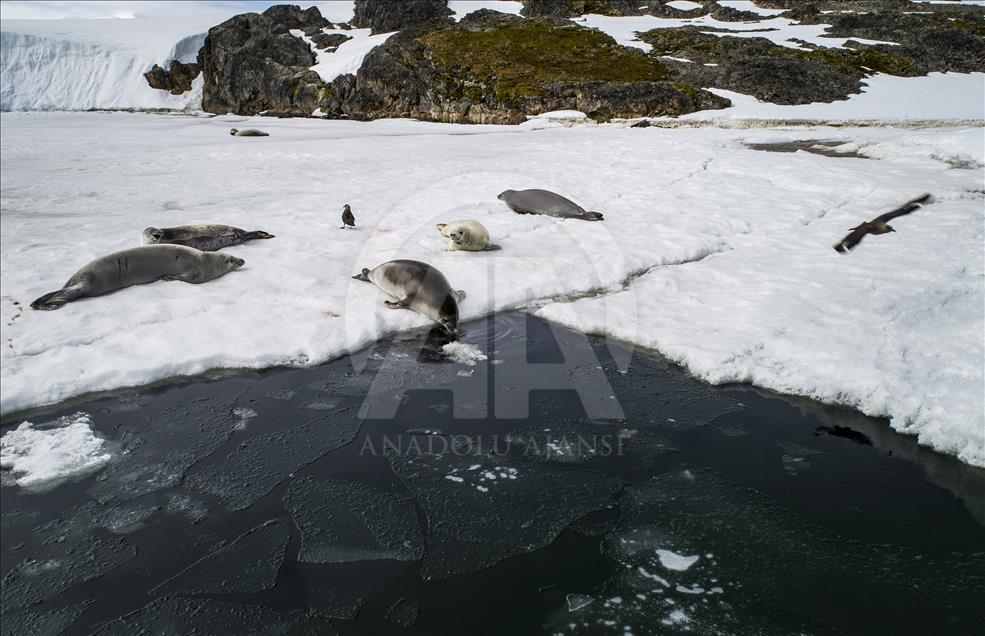
ANTARCTICA - FEBRUARY 09 : Crabeater seals are seen on Galindez Island, Antarctica on February 9, 2019. Turkey organized National Science Antarctica expedition for the 3rd time. Antarctica has been attracting scientific research teams and explorers with its challenging geography and nature throughout the history. Besides its attractiveness the continent is the world's coldest, most windy and arid place. For these reasons bases established here are allowed only for scientific research. The continent, which is not under the rule of any country, is called the continent of science and peace. 98 percent of the continent is covered almost entirely by ice that averages about a mile (1.6 kilometers) thick where 67 percent of the freshwater source on earth is found. During the winter season, sea ice fields covering about 18 million square kilometers, fall approximately 2 to 3 million square kilometer in the summer. The untouched nature of Antarctica is of great importance for the future of the world. The live water resources of the continent and the water potential in the glaciers are seen as the future water and food security of earth. Antarctica is the only continent on Earth without indigenous human inhabitants It only hosts various animals such as penguins, seals, whales and birds. The Antarctic Treaty, which was signed in 1959 when 53 countries were a party, allowed only bases with scientific studies and research to be active on the continent. There are about 100 scientific bases of 30 countries on the continent. ( Özge Elif Kızıl - Anadolu Agency )
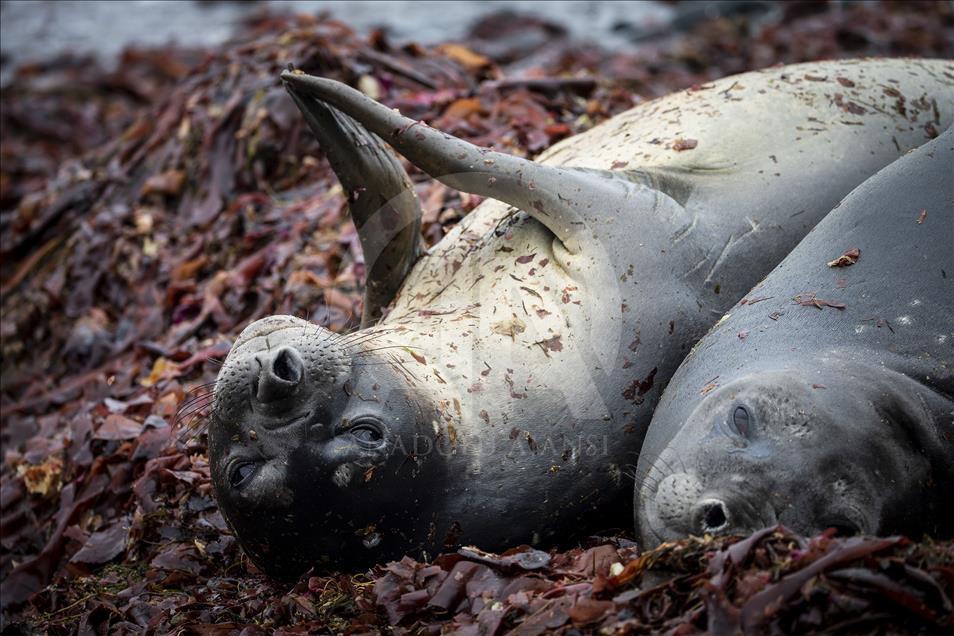
ANTARCTICA - FEBRUARY 06 : Elephant seals, the largest species of seal family are seen on King George Island, Antarctica on February 6, 2019. Turkey organized National Science Antarctica expedition for the 3rd time. Antarctica has been attracting scientific research teams and explorers with its challenging geography and nature throughout the history. Besides its attractiveness the continent is the world's coldest, most windy and arid place. For these reasons bases established here are allowed only for scientific research. The continent, which is not under the rule of any country, is called the continent of science and peace. 98 percent of the continent is covered almost entirely by ice that averages about a mile (1.6 kilometers) thick where 67 percent of the freshwater source on earth is found. During the winter season, sea ice fields covering about 18 million square kilometers, fall approximately 2 to 3 million square kilometer in the summer. The untouched nature of Antarctica is of great importance for the future of the world. The live water resources of the continent and the water potential in the glaciers are seen as the future water and food security of earth. Antarctica is the only continent on Earth without indigenous human inhabitants It only hosts various animals such as penguins, seals, whales and birds. The Antarctic Treaty, which was signed in 1959 when 53 countries were a party, allowed only bases with scientific studies and research to be active on the continent. There are about 100 scientific bases of 30 countries on the continent. ( Özge Elif Kızıl - Anadolu Agency )
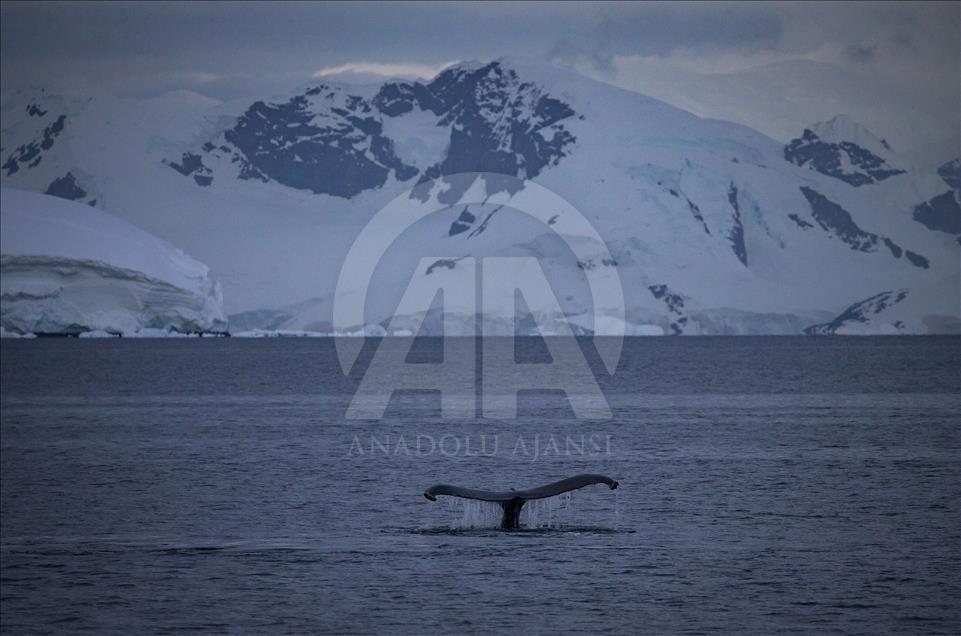
ANTARCTICA - FEBRUARY 09: A humpback whale is watched in Garlache Strait in Antarctica, on February 9, 2019. Turkey organized National Science Antarctica expedition for the 3rd time. Antarctica has been attracting scientific research teams and explorers with its challenging geography and nature throughout the history. Besides its attractiveness the continent is the world's coldest, most windy and arid place. For these reasons bases established here are allowed only for scientific research. The continent, which is not under the rule of any country, is called the continent of science and peace. 98 percent of the continent is covered almost entirely by ice that averages about a mile (1.6 kilometers) thick where 67 percent of the freshwater source on earth is found. During the winter season, sea ice fields covering about 18 million square kilometers, fall approximately 2 to 3 million square kilometer in the summer. The untouched nature of Antarctica is of great importance for the future of the world. The live water resources of the continent and the water potential in the glaciers are seen as the future water and food security of earth. Antarctica is the only continent on Earth without indigenous human inhabitants It only hosts various animals such as penguins, seals, whales and birds. The Antarctic Treaty, which was signed in 1959 when 53 countries were a party, allowed only bases with scientific studies and research to be active on the continent. There are about 100 scientific bases of 30 countries on the continent. ( Özge Elif Kızıl - Anadolu Agency )
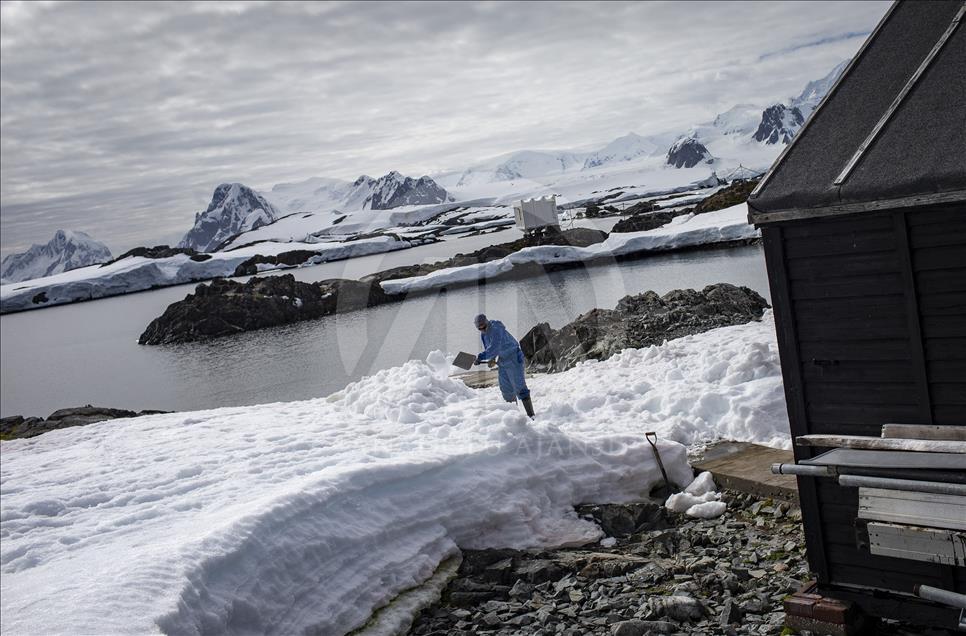
ANTARCTICA - FEBRUARY 09 : A scientific research team member shovels snow off of a path outside Vernadsky Research Base, a Ukrainian Antarctic Station at Marina Point on Galindez Island, Antarctica, on February 09, 2019. Turkey organized National Science Antarctica Expedition for the 3rd time. Antarctica has been attracting scientific research teams and explorers with its challenging geography and nature throughout the history. Besides its attractiveness the continent is the world's coldest, most windy and arid place. For these reasons bases established here are allowed only for scientific research. The continent, which is not under the rule of any country, is called the continent of science and peace. 98 percent of the continent is covered almost entirely by ice that averages about a mile (1.6 kilometers) thick where 67 percent of the freshwater source on earth is found. During the winter season, sea ice fields covering about 18 million square kilometers, fall approximately 2 to 3 million square kilometer in the summer. The untouched nature of Antarctica is of great importance for the future of the world. The live water resources of the continent and the water potential in the glaciers are seen as the future water and food security of earth. Antarctica is the only continent on Earth without indigenous human inhabitants It only hosts various animals such as penguins, seals, whales and birds. The Antarctic Treaty, which was signed in 1959 when 53 countries were a party, allowed only bases with scientific studies and research to be active on the continent. There are about 100 scientific bases of 30 countries on the continent. ( Özge Elif Kızıl - Anadolu Agency )
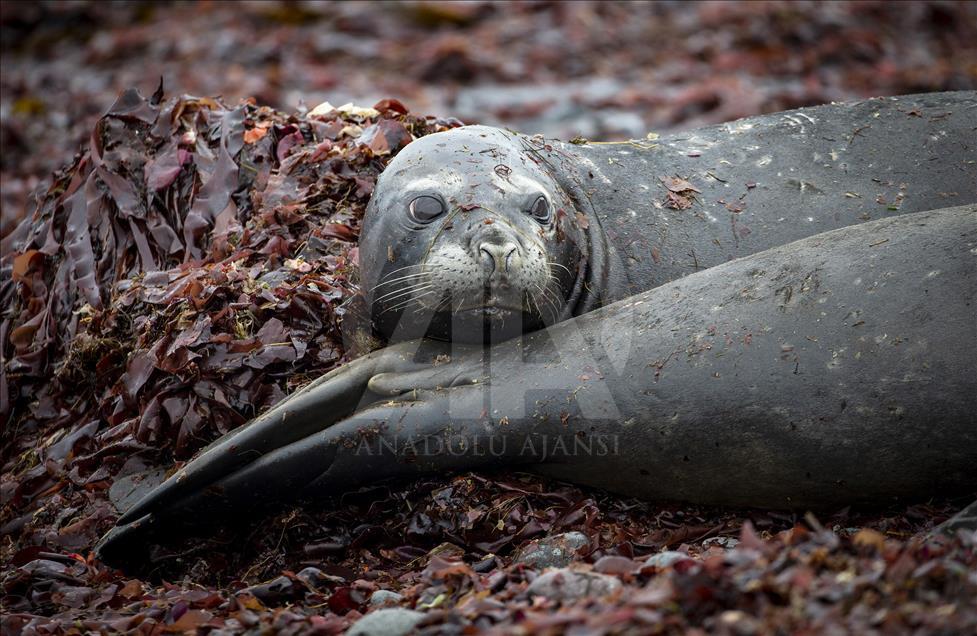
ANTARCTICA - FEBRUARY 06 : Elephant seals, the largest species of seal family are seen on King George Island, Antarctica on February 6, 2019. Turkey organized National Science Antarctica expedition for the 3rd time. Antarctica has been attracting scientific research teams and explorers with its challenging geography and nature throughout the history. Besides its attractiveness the continent is the world's coldest, most windy and arid place. For these reasons bases established here are allowed only for scientific research. The continent, which is not under the rule of any country, is called the continent of science and peace. 98 percent of the continent is covered almost entirely by ice that averages about a mile (1.6 kilometers) thick where 67 percent of the freshwater source on earth is found. During the winter season, sea ice fields covering about 18 million square kilometers, fall approximately 2 to 3 million square kilometer in the summer. The untouched nature of Antarctica is of great importance for the future of the world. The live water resources of the continent and the water potential in the glaciers are seen as the future water and food security of earth. Antarctica is the only continent on Earth without indigenous human inhabitants It only hosts various animals such as penguins, seals, whales and birds. The Antarctic Treaty, which was signed in 1959 when 53 countries were a party, allowed only bases with scientific studies and research to be active on the continent. There are about 100 scientific bases of 30 countries on the continent. ( Özge Elif Kızıl - Anadolu Agency )

ANTARCTICA - FEBRUARY 09 : Crabeater seals are seen on a ice in Gerlache Channel in Antarctica on February 9, 2019. Turkey organized National Science Antarctica expedition for the 3rd time. Antarctica has been attracting scientific research teams and explorers with its challenging geography and nature throughout the history. Besides its attractiveness the continent is the world's coldest, most windy and arid place. For these reasons bases established here are allowed only for scientific research. The continent, which is not under the rule of any country, is called the continent of science and peace. 98 percent of the continent is covered almost entirely by ice that averages about a mile (1.6 kilometers) thick where 67 percent of the freshwater source on earth is found. During the winter season, sea ice fields covering about 18 million square kilometers, fall approximately 2 to 3 million square kilometer in the summer. The untouched nature of Antarctica is of great importance for the future of the world. The live water resources of the continent and the water potential in the glaciers are seen as the future water and food security of earth. Antarctica is the only continent on Earth without indigenous human inhabitants It only hosts various animals such as penguins, seals, whales and birds. The Antarctic Treaty, which was signed in 1959 when 53 countries were a party, allowed only bases with scientific studies and research to be active on the continent. There are about 100 scientific bases of 30 countries on the continent. ( Özge Elif Kızıl - Anadolu Agency )
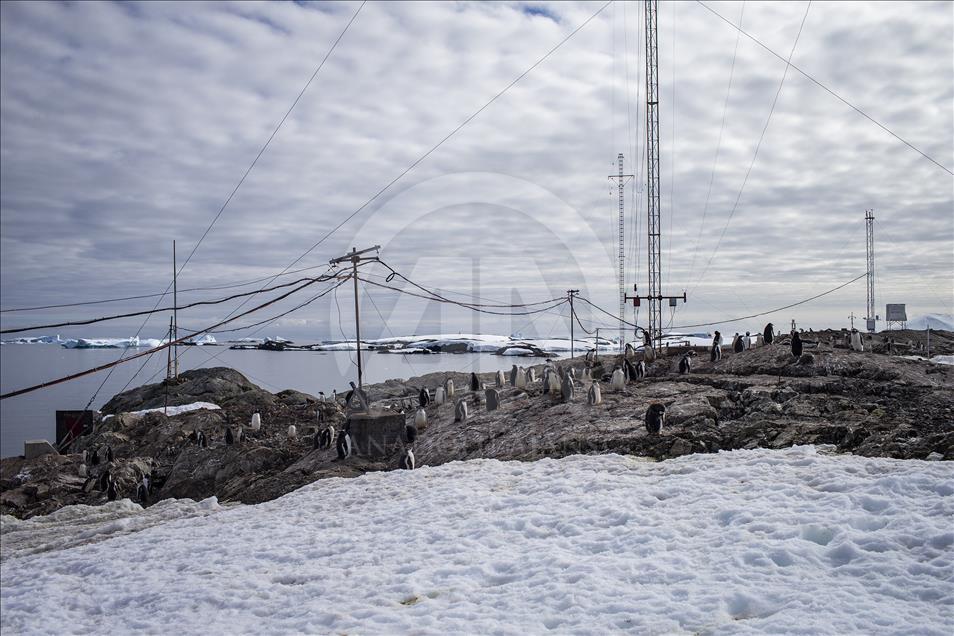
ANTARCTICA - FEBRUARY 09 : Gentoo penguins stand on a land rock near Vernadsky Research Base, a Ukrainian Antarctic Station at Marina Point on Galindez Island, Antarctica, on February 09, 2019. Turkey organized National Science Antarctica Expedition for the 3rd time. Antarctica has been attracting scientific research teams and explorers with its challenging geography and nature throughout the history. Besides its attractiveness the continent is the world's coldest, most windy and arid place. For these reasons bases established here are allowed only for scientific research. The continent, which is not under the rule of any country, is called the continent of science and peace. 98 percent of the continent is covered almost entirely by ice that averages about a mile (1.6 kilometers) thick where 67 percent of the freshwater source on earth is found. During the winter season, sea ice fields covering about 18 million square kilometers, fall approximately 2 to 3 million square kilometer in the summer. The untouched nature of Antarctica is of great importance for the future of the world. The live water resources of the continent and the water potential in the glaciers are seen as the future water and food security of earth. Antarctica is the only continent on Earth without indigenous human inhabitants It only hosts various animals such as penguins, seals, whales and birds. The Antarctic Treaty, which was signed in 1959 when 53 countries were a party, allowed only bases with scientific studies and research to be active on the continent. There are about 100 scientific bases of 30 countries on the continent. ( Özge Elif Kızıl - Anadolu Agency )
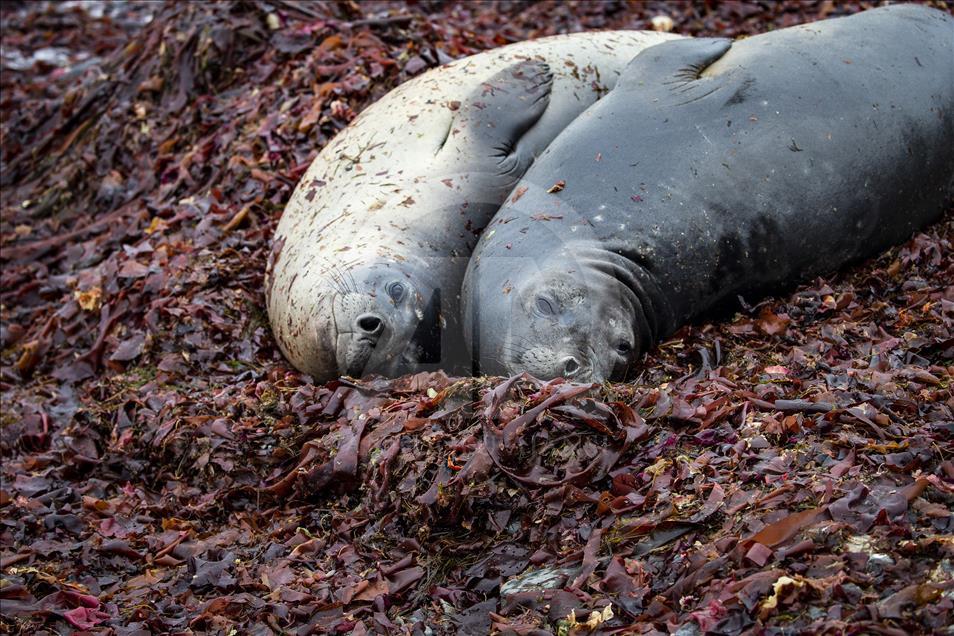
ANTARCTICA - FEBRUARY 06 : Elephant seals, the largest species of seal family are seen on King George Island, Antarctica on February 6, 2019. Turkey organized National Science Antarctica expedition for the 3rd time. Antarctica has been attracting scientific research teams and explorers with its challenging geography and nature throughout the history. Besides its attractiveness the continent is the world's coldest, most windy and arid place. For these reasons bases established here are allowed only for scientific research. The continent, which is not under the rule of any country, is called the continent of science and peace. 98 percent of the continent is covered almost entirely by ice that averages about a mile (1.6 kilometers) thick where 67 percent of the freshwater source on earth is found. During the winter season, sea ice fields covering about 18 million square kilometers, fall approximately 2 to 3 million square kilometer in the summer. The untouched nature of Antarctica is of great importance for the future of the world. The live water resources of the continent and the water potential in the glaciers are seen as the future water and food security of earth. Antarctica is the only continent on Earth without indigenous human inhabitants It only hosts various animals such as penguins, seals, whales and birds. The Antarctic Treaty, which was signed in 1959 when 53 countries were a party, allowed only bases with scientific studies and research to be active on the continent. There are about 100 scientific bases of 30 countries on the continent. ( Özge Elif Kızıl - Anadolu Agency )
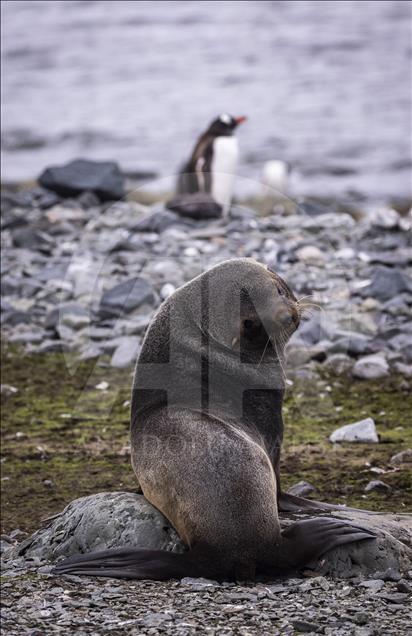
ANTARCTICA - FEBRUARY 05 : A fur seal is seen on Ardley Island, Antarctica on February 5, 2019. Turkey organized National Science Antarctica expedition for the 3rd time. Antarctica has been attracting scientific research teams and explorers with its challenging geography and nature throughout the history. Besides its attractiveness the continent is the world's coldest, most windy and arid place. For these reasons bases established here are allowed only for scientific research. The continent, which is not under the rule of any country, is called the continent of science and peace. 98 percent of the continent is covered almost entirely by ice that averages about a mile (1.6 kilometers) thick where 67 percent of the freshwater source on earth is found. During the winter season, sea ice fields covering about 18 million square kilometers, fall approximately 2 to 3 million square kilometer in the summer. The untouched nature of Antarctica is of great importance for the future of the world. The live water resources of the continent and the water potential in the glaciers are seen as the future water and food security of earth. Antarctica is the only continent on Earth without indigenous human inhabitants It only hosts various animals such as penguins, seals, whales and birds. The Antarctic Treaty, which was signed in 1959 when 53 countries were a party, allowed only bases with scientific studies and research to be active on the continent. There are about 100 scientific bases of 30 countries on the continent. ( Özge Elif Kızıl - Anadolu Agency )

ANTARCTICA - FEBRUARY 09 : Barrels are being loaded on a pier on the shore of Vernadsky Research Base, a Ukrainian Antarctic Station at Marina Point on Galindez Island, Antarctica, on February 09, 2019. Turkey organized National Science Antarctica Expedition for the 3rd time. Antarctica has been attracting scientific research teams and explorers with its challenging geography and nature throughout the history. Besides its attractiveness the continent is the world's coldest, most windy and arid place. For these reasons bases established here are allowed only for scientific research. The continent, which is not under the rule of any country, is called the continent of science and peace. 98 percent of the continent is covered almost entirely by ice that averages about a mile (1.6 kilometers) thick where 67 percent of the freshwater source on earth is found. During the winter season, sea ice fields covering about 18 million square kilometers, fall approximately 2 to 3 million square kilometer in the summer. The untouched nature of Antarctica is of great importance for the future of the world. The live water resources of the continent and the water potential in the glaciers are seen as the future water and food security of earth. Antarctica is the only continent on Earth without indigenous human inhabitants It only hosts various animals such as penguins, seals, whales and birds. The Antarctic Treaty, which was signed in 1959 when 53 countries were a party, allowed only bases with scientific studies and research to be active on the continent. There are about 100 scientific bases of 30 countries on the continent. ( Özge Elif Kızıl - Anadolu Agency )
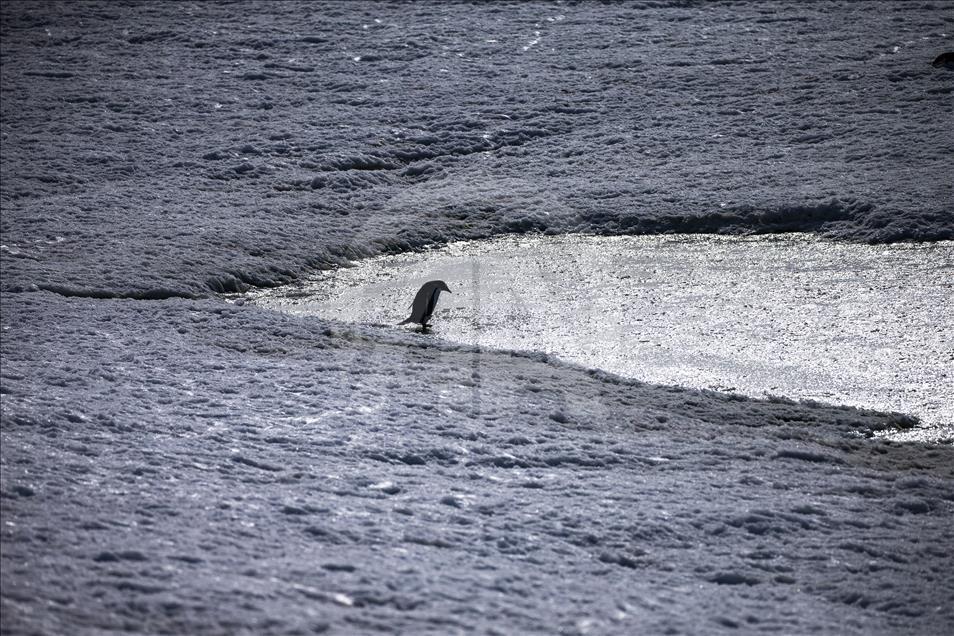
ANTARCTICA - FEBRUARY 09 : A Gentoo penguin is seen on an ice covered field near Vernadsky Research Base, a Ukrainian Antarctic Station at Marina Point on Galindez Island, Antarctica, on February 09, 2019. Turkey organized National Science Antarctica Expedition for the 3rd time. Antarctica has been attracting scientific research teams and explorers with its challenging geography and nature throughout the history. Besides its attractiveness the continent is the world's coldest, most windy and arid place. For these reasons bases established here are allowed only for scientific research. The continent, which is not under the rule of any country, is called the continent of science and peace. 98 percent of the continent is covered almost entirely by ice that averages about a mile (1.6 kilometers) thick where 67 percent of the freshwater source on earth is found. During the winter season, sea ice fields covering about 18 million square kilometers, fall approximately 2 to 3 million square kilometer in the summer. The untouched nature of Antarctica is of great importance for the future of the world. The live water resources of the continent and the water potential in the glaciers are seen as the future water and food security of earth. Antarctica is the only continent on Earth without indigenous human inhabitants It only hosts various animals such as penguins, seals, whales and birds. The Antarctic Treaty, which was signed in 1959 when 53 countries were a party, allowed only bases with scientific studies and research to be active on the continent. There are about 100 scientific bases of 30 countries on the continent. ( Özge Elif Kızıl - Anadolu Agency )
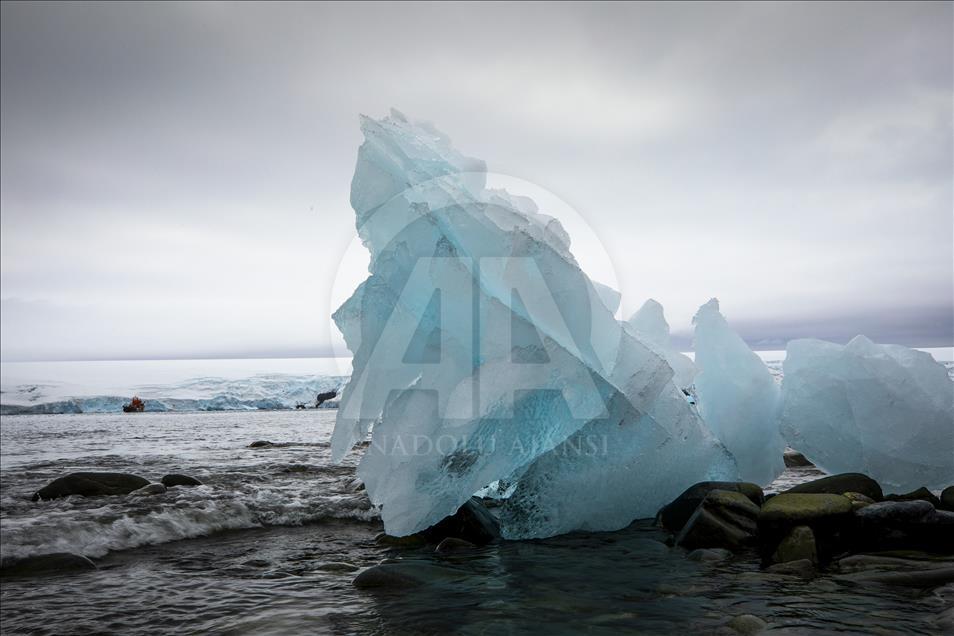
ANTARCTICA - FEBRUARY 07 : Shore of Bulgaria's St. Kliment Ohridski Base is covered with ice floes at Livingston Island, an Antarctic island in the South Shetland Islands, Western Antarctica lying between Greenwich Island and Snow Islands, on February 07, 2019. Turkey organized National Science Antarctica Expedition for the 3rd time. Antarctica has been attracting scientific research teams and explorers with its challenging geography and nature throughout the history. Besides its attractiveness the continent is the world's coldest, most windy and arid place. For these reasons bases established here are allowed only for scientific research. The continent, which is not under the rule of any country, is called the continent of science and peace. 98 percent of the continent is covered almost entirely by ice that averages about a mile (1.6 kilometers) thick where 67 percent of the freshwater source on earth is found. During the winter season, sea ice fields covering about 18 million square kilometers, fall approximately 2 to 3 million square kilometer in the summer. The untouched nature of Antarctica is of great importance for the future of the world. The live water resources of the continent and the water potential in the glaciers are seen as the future water and food security of earth. Antarctica is the only continent on Earth without indigenous human inhabitants It only hosts various animals such as penguins, seals, whales and birds. The Antarctic Treaty, which was signed in 1959 when 53 countries were a party, allowed only bases with scientific studies and research to be active on the continent. There are about 100 scientific bases of 30 countries on the continent. ( Özge Elif Kızıl - Anadolu Agency )
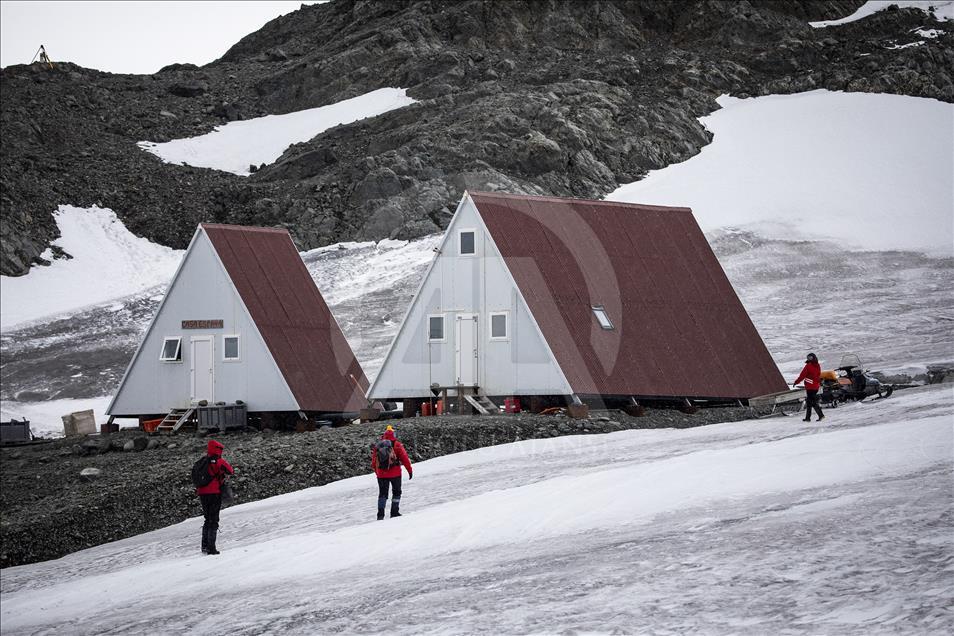
ANTARCTICA - FEBRUARY 07 : Scientific research team members are seen around Bulgaria's St. Kliment Ohridski Base at Livingston Island, an Antarctic island in the South Shetland Islands, Western Antarctica lying between Greenwich Island and Snow Islands, on February 07, 2019. Turkey organized National Science Antarctica Expedition for the 3rd time. Antarctica has been attracting scientific research teams and explorers with its challenging geography and nature throughout the history. Besides its attractiveness the continent is the world's coldest, most windy and arid place. For these reasons bases established here are allowed only for scientific research. The continent, which is not under the rule of any country, is called the continent of science and peace. 98 percent of the continent is covered almost entirely by ice that averages about a mile (1.6 kilometers) thick where 67 percent of the freshwater source on earth is found. During the winter season, sea ice fields covering about 18 million square kilometers, fall approximately 2 to 3 million square kilometer in the summer. The untouched nature of Antarctica is of great importance for the future of the world. The live water resources of the continent and the water potential in the glaciers are seen as the future water and food security of earth. Antarctica is the only continent on Earth without indigenous human inhabitants It only hosts various animals such as penguins, seals, whales and birds. The Antarctic Treaty, which was signed in 1959 when 53 countries were a party, allowed only bases with scientific studies and research to be active on the continent. There are about 100 scientific bases of 30 countries on the continent. ( Özge Elif Kızıl - Anadolu Agency )

ANTARCTICA - FEBRUARY 09 : Assistant Prof. Dr. Sevil Deniz Yakan Dundar (4th L), ITU Faculty of Naval Architecture and Marine Sciences Faculty, Assistant Prof. Dr. Burak Karacik (L), Istanbul Technical University - Faculty of Naval Architecture and Ocean Engineering, Bilge Tutak (2nd L) Istanbul Technical University - Faculty of Naval Architecture and Ocean Engineering Ship and Marine Engineering Faculty and their teammates leave passive sampler water gage to the sea, which does not harm the sea creatures, on a boat in Antarctica, on February 09, 2019. Turkish scientific research team began their journey within the 3rd National Science Antarctica Expedition, under the auspices of Presidency of Turkey and under the coordination of the Ministry of Industry and Technology and Istanbul Technical University (ITU) Polar Research Center (PolReC). Scientists carry out studies in different fields such as polar biodiversity, living sciences, ecology and marine sciences at the white continent. The Turkish team from the King George Island of Antarctica took their way through the visually impressive Gerlache and Lemaire passages to the Horseshoe Island where the Turkish Science Camp was to be established. ( Özge Elif Kızıl - Anadolu Agency )

ANTARCTICA - FEBRUARY 09 : Assistant Prof. Dr. Sevil Deniz Yakan Dundar ITU Faculty of Naval Architecture and Marine Sciences Faculty collects sample pieces from the sea to analyse the human induced pollution ratio in Antarctica, on February 09, 2019. Turkish scientific research team began their journey within the 3rd National Science Antarctica Expedition, under the auspices of Presidency of Turkey and under the coordination of the Ministry of Industry and Technology and Istanbul Technical University (ITU) Polar Research Center (PolReC). Scientists carry out studies in different fields such as polar biodiversity, living sciences, ecology and marine sciences at the white continent. The Turkish team from the King George Island of Antarctica took their way through the visually impressive Gerlache and Lemaire passages to the Horseshoe Island where the Turkish Science Camp was to be established. ( Özge Elif Kızıl - Anadolu Agency )
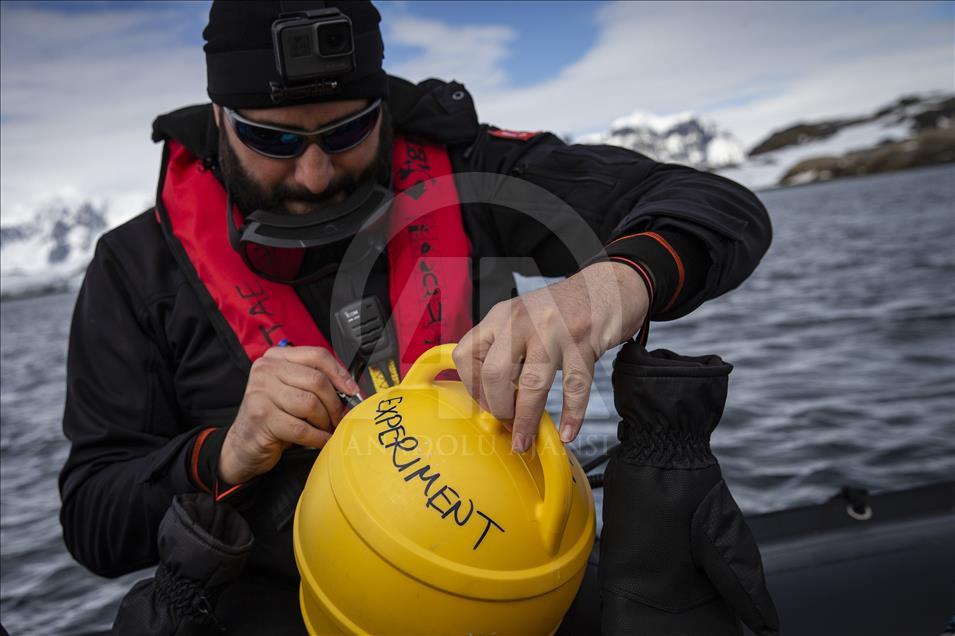
ANTARCTICA - FEBRUARY 09 : Bilge Tutak Istanbul Technical University - Faculty of Naval Architecture and Ocean Engineering Ship and Marine Engineering Faculty writes the warning letters on the passive sampler water gage to leave the sea, which does not harm the sea creatures, on a zodiac boat in Antarctica, on February 09, 2019. Turkish scientific research team began their journey within the 3rd National Science Antarctica Expedition, under the auspices of Presidency of Turkey and under the coordination of the Ministry of Industry and Technology and Istanbul Technical University (ITU) Polar Research Center (PolReC). Scientists carry out studies in different fields such as polar biodiversity, living sciences, ecology and marine sciences at the white continent. The Turkish team from the King George Island of Antarctica took their way through the visually impressive Gerlache and Lemaire passages to the Horseshoe Island where the Turkish Science Camp was to be established. ( Özge Elif Kızıl - Anadolu Agency )
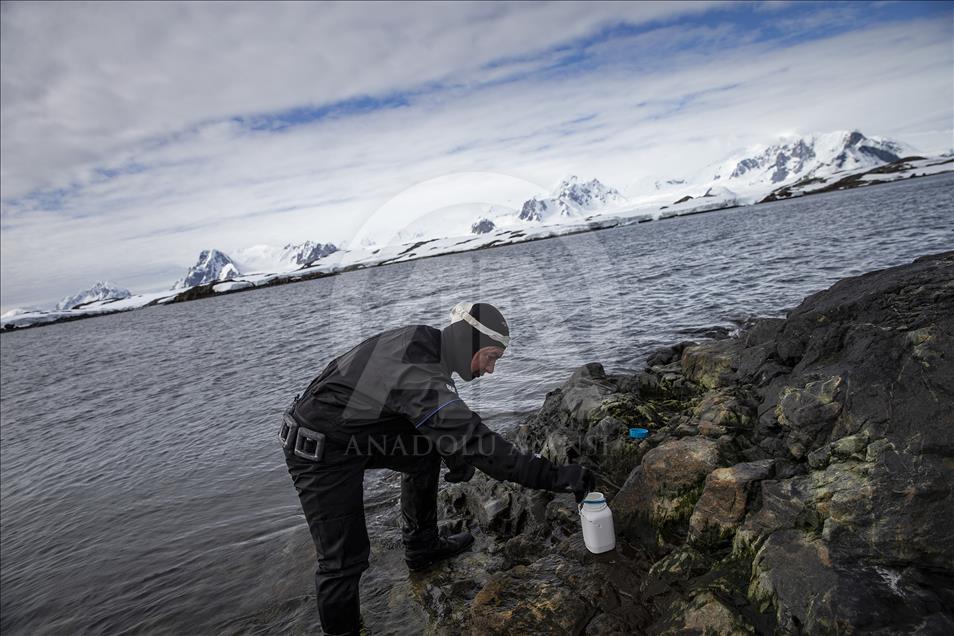
ANTARCTICA - FEBRUARY 09 : Assistant Prof. Dr. Burak Karacik, Istanbul Technical University - Faculty of Naval Architecture and Ocean Engineering, receives sea shell samples from the rocks to analyse the human induced pollution in Antarctica, on February 09, 2019. Turkish scientific research team began their journey within the 3rd National Science Antarctica Expedition, under the auspices of Presidency of Turkey and under the coordination of the Ministry of Industry and Technology and Istanbul Technical University (ITU) Polar Research Center (PolReC). Scientists carry out studies in different fields such as polar biodiversity, living sciences, ecology and marine sciences at the white continent. The Turkish team from the King George Island of Antarctica took their way through the visually impressive Gerlache and Lemaire passages to the Horseshoe Island where the Turkish Science Camp was to be established. ( Özge Elif Kızıl - Anadolu Agency )
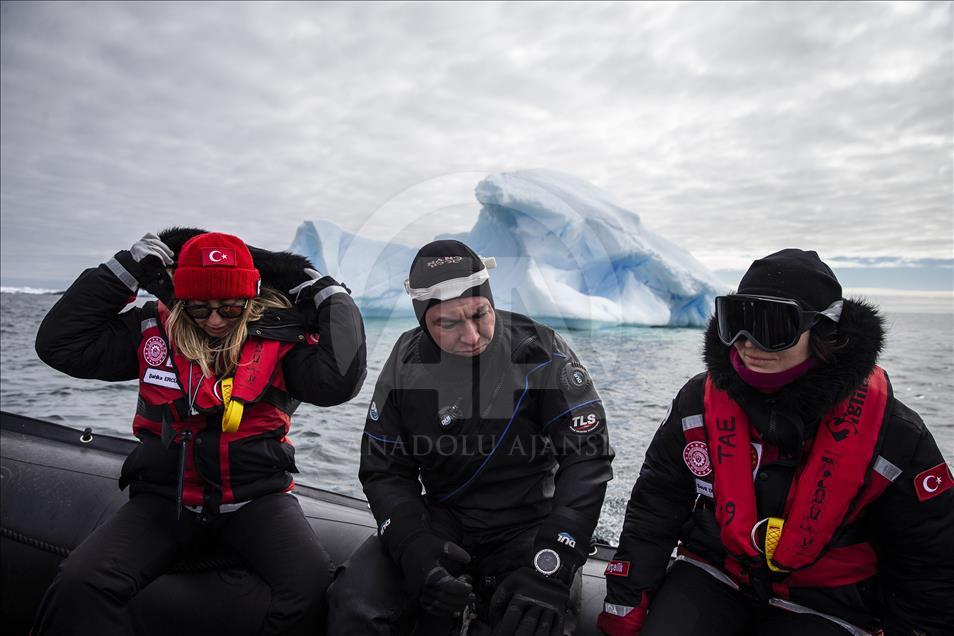
ANTARCTICA - FEBRUARY 09 : Assistant Prof. Dr. Burak Karacik (C), Istanbul Technical University - Faculty of Naval Architecture and Ocean Engineering, Assistant Prof. Dr. Sevil Deniz Yakan Dundar (R) ITU Faculty of Naval Architecture and Marine Sciences Faculty and Turkish world record-holder free-diver Sahika Encumen (L) are seen on a zodiac boat before collecting sample pieces from the sea to analyse the human induced pollution ratio in Antarctica, on February 09, 2019. Turkish scientific research team began their journey within the 3rd National Science Antarctica Expedition, under the auspices of Presidency of Turkey and under the coordination of the Ministry of Industry and Technology and Istanbul Technical University (ITU) Polar Research Center (PolReC). Scientists carry out studies in different fields such as polar biodiversity, living sciences, ecology and marine sciences at the white continent. The Turkish team from the King George Island of Antarctica took their way through the visually impressive Gerlache and Lemaire passages to the Horseshoe Island where the Turkish Science Camp was to be established. ( Özge Elif Kızıl - Anadolu Agency )

ANTARCTICA - FEBRUARY 09 : Prof. Dr. Sedat Serce - Nigde Omer Halisdemir University Faculty of Agricultural Sciences and Technologies collects plant, soil and seed samples from rocks near Vernadsky Research Base of Ukraine, in Antarctica, on February 09, 2019. Turkish scientific research team began their journey within the 3rd National Science Antarctica Expedition, under the auspices of Presidency of Turkey and under the coordination of the Ministry of Industry and Technology and Istanbul Technical University (ITU) Polar Research Center (PolReC). Scientists carry out studies in different fields such as polar biodiversity, living sciences, ecology and marine sciences at the white continent. The Turkish team took off from the King George Island of Antarctica and made their way through Gerlache and Lemaire passages towards Horseshoe Island to set up the Turkish Science Camp. ( Özge Elif Kızıl - Anadolu Agency )

ANTARCTICA - FEBRUARY 09 : Prof. Dr. Marine Biologist Contact Selahattin Unsal Karhan (2nd R) and Istanbul Technical University - Faculty of Naval Architecture and Ocean Engineering Ship and Marine Engineering Faculty Member Bilge Tutak, 38, (4th L) collect DNA samples from the sea, in Antarctica, at Vernadsky Research Base of Ukraine, in Antarctica, on February 09, 2019. Turkish scientific research team began their journey within the 3rd National Science Antarctica Expedition, under the auspices of Presidency of Turkey and under the coordination of the Ministry of Industry and Technology and Istanbul Technical University (ITU) Polar Research Center (PolReC). Scientists carry out studies in different fields such as polar biodiversity, living sciences, ecology and marine sciences at the white continent. The Turkish team took off from the King George Island of Antarctica and made their way through Gerlache and Lemaire passages towards Horseshoe Island to set up the Turkish Science Camp. ( Özge Elif Kızıl - Anadolu Agency )
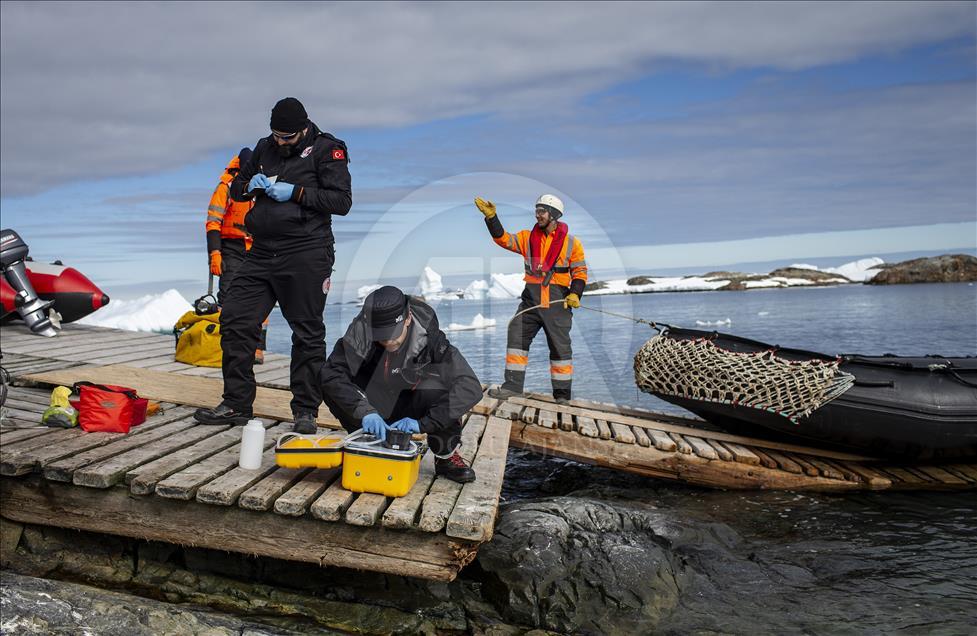
ANTARCTICA - FEBRUARY 09 : Prof. Dr. Marine Biologist Contact Selahattin Unsal Karhan (R) and Istanbul Technical University - Faculty of Naval Architecture and Ocean Engineering Ship and Marine Engineering Faculty Member Bilge Tutak, 38, (L) prepare their equipments to collect DNA samples from the sea, at Vernadsky Research Base of Ukraine, in Antarctica, on February 09, 2019. Turkish scientific research team began their journey within the 3rd National Science Antarctica Expedition, under the auspices of Presidency of Turkey and under the coordination of the Ministry of Industry and Technology and Istanbul Technical University (ITU) Polar Research Center (PolReC). Scientists carry out studies in different fields such as polar biodiversity, living sciences, ecology and marine sciences at the white continent. The Turkish team took off from the King George Island of Antarctica and made their way through Gerlache and Lemaire passages towards Horseshoe Island to set up the Turkish Science Camp. ( Özge Elif Kızıl - Anadolu Agency )
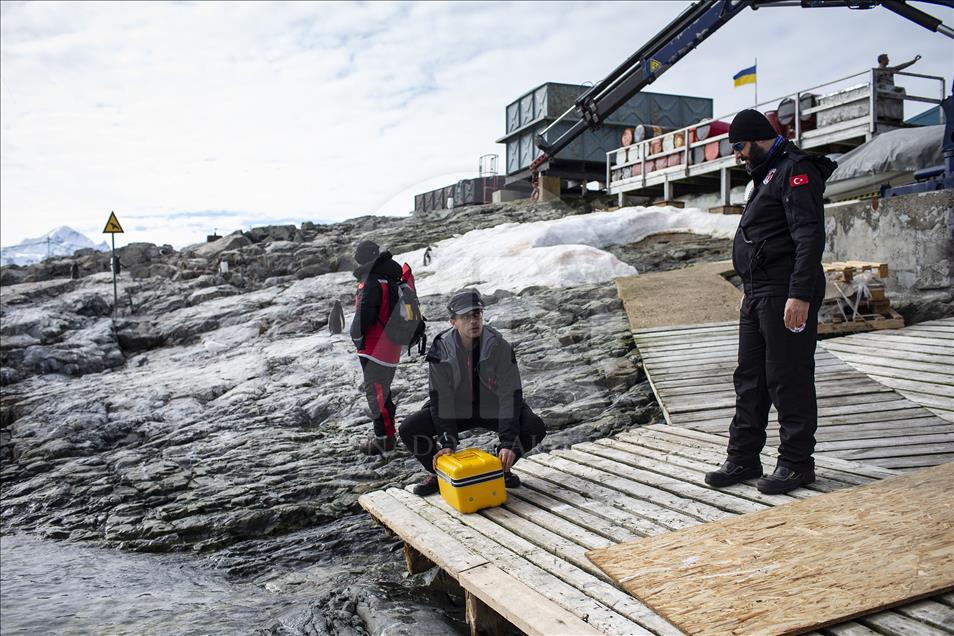
ANTARCTICA - FEBRUARY 09 : Prof. Dr. Marine Biologist Contact Selahattin Unsal Karhan (C) and Istanbul Technical University - Faculty of Naval Architecture and Ocean Engineering Ship and Marine Engineering Faculty Member Bilge Tutak, 38, (R) prepare their equipments to receive DNA samples from the sea, at Vernadsky Research Base of Ukraine, in Antarctica, on February 09, 2019. Turkish scientific research team began their journey within the 3rd National Science Antarctica Expedition, under the auspices of Presidency of Turkey and under the coordination of the Ministry of Industry and Technology and Istanbul Technical University (ITU) Polar Research Center (PolReC). Scientists carry out studies in different fields such as polar biodiversity, living sciences, ecology and marine sciences at the white continent. The Turkish team took off from the King George Island of Antarctica and made their way through Gerlache and Lemaire passages towards Horseshoe Island to set up the Turkish Science Camp. ( Özge Elif Kızıl - Anadolu Agency )
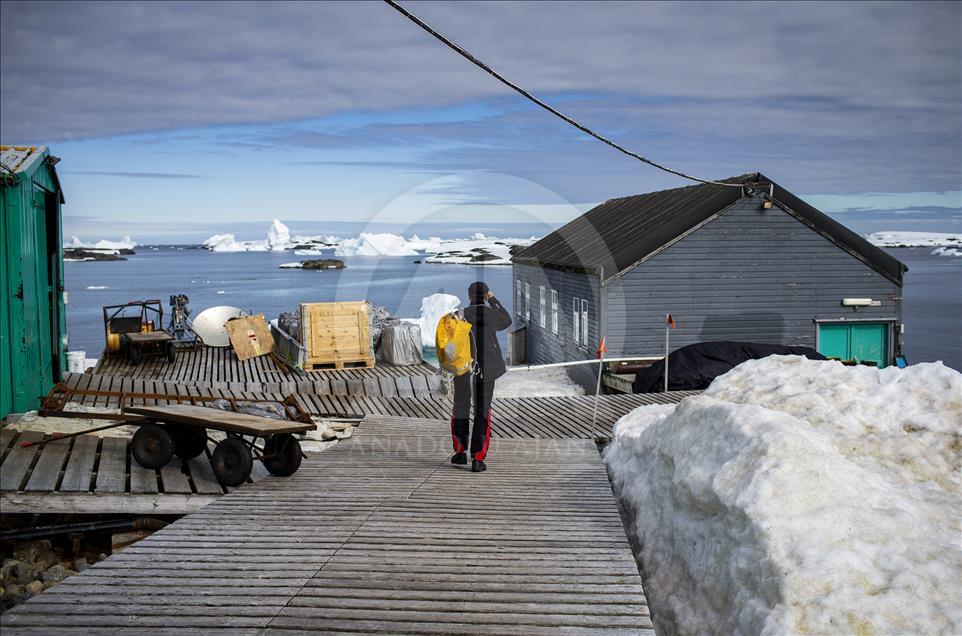
ANTARCTICA - FEBRUARY 09 : Prof. Dr. Marine Biologist Contact Selahattin Unsal Karhan walks at Vernadsky Research Base shores of Ukraine, before collecting samples from the sea, at Vernadsky Research Base of Ukraine, in Antarctica, on February 09, 2019. Turkish scientific research team began their journey within the 3rd National Science Antarctica Expedition, under the auspices of Presidency of Turkey and under the coordination of the Ministry of Industry and Technology and Istanbul Technical University (ITU) Polar Research Center (PolReC). Scientists carry out studies in different fields such as polar biodiversity, living sciences, ecology and marine sciences at the white continent. The Turkish team took off from the King George Island of Antarctica and made their way through Gerlache and Lemaire passages towards Horseshoe Island to set up the Turkish Science Camp. ( Özge Elif Kızıl - Anadolu Agency )

ANTARCTICA - FEBRUARY 09 : Prof. Dr. Ersan Basar Karadeniz Technical University Faculty of Marine Sciences Faculty Member collects snow samples near Vernadsky Research Base of Ukraine, in Antarctica, on February 09, 2019. Turkish scientific research team began their journey within the 3rd National Science Antarctica Expedition, under the auspices of Presidency of Turkey and under the coordination of the Ministry of Industry and Technology and Istanbul Technical University (ITU) Polar Research Center (PolReC). Scientists carry out studies in different fields such as polar biodiversity, living sciences, ecology and marine sciences at the white continent. The Turkish team took off from the King George Island of Antarctica and made their way through Gerlache and Lemaire passages towards Horseshoe Island to set up the Turkish Science Camp. ( Özge Elif Kızıl - Anadolu Agency )

ANTARCTICA - FEBRUARY 09 : Prof. Dr. Ersan Basar Karadeniz Technical University Faculty of Marine Sciences Faculty Member and his teammates walk near Vernadsky Research Base of Ukraine to take samples, in Antarctica, on February 09, 2019. Turkish scientific research team began their journey within the 3rd National Science Antarctica Expedition, under the auspices of Presidency of Turkey and under the coordination of the Ministry of Industry and Technology and Istanbul Technical University (ITU) Polar Research Center (PolReC). Scientists carry out studies in different fields such as polar biodiversity, living sciences, ecology and marine sciences at the white continent. The Turkish team took off from the King George Island of Antarctica and made their way through Gerlache and Lemaire passages towards Horseshoe Island to set up the Turkish Science Camp. ( Özge Elif Kızıl - Anadolu Agency )

ANTARCTICA - FEBRUARY 08 : Scientists watch the view from deck as they pass through the Lemaire Channel, in Antarctica, Polar Regions on February 08, 2019. Turkish scientific research team began their journey within the 3rd National Science Antarctica Expedition, under the auspices of Presidency of Turkey and under the coordination of the Ministry of Industry and Technology and Istanbul Technical University (ITU) Polar Research Center (PolReC). Scientists carry out studies in different fields such as polar biodiversity, living sciences, ecology and marine sciences at the white continent. The Turkish team took off from the King George Island of Antarctica and made their way through Gerlache and Lemaire passages towards Horseshoe Island to set up the Turkish Science Camp. ( Özge Elif Kızıl - Anadolu Agency )
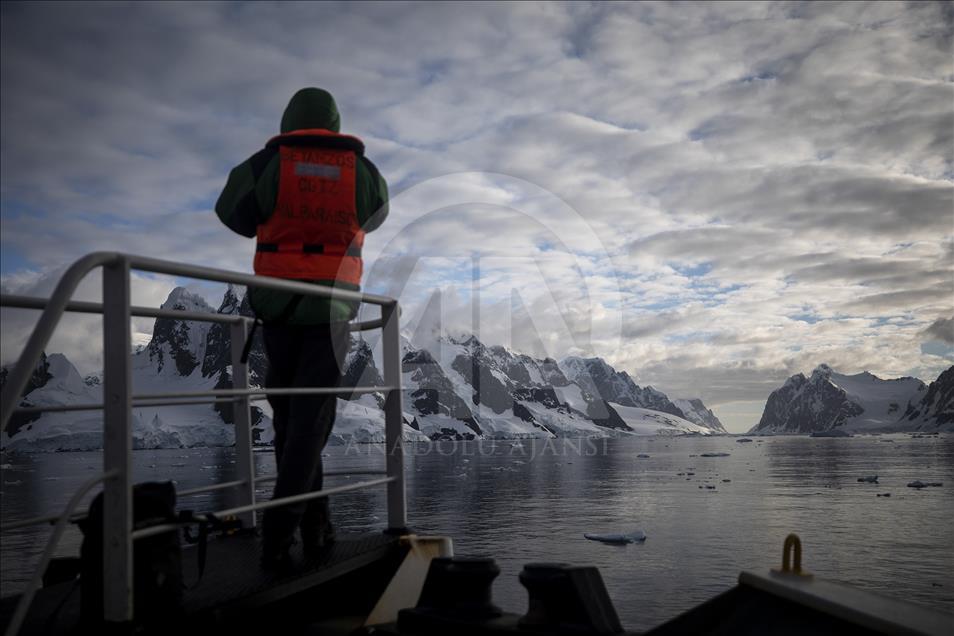
ANTARCTICA - FEBRUARY 08 : A scientist watches the view from deck as they pass through the Lemaire Channel, in Antarctica, Polar Regions on February 08, 2019. Turkish scientific research team began their journey within the 3rd National Science Antarctica Expedition, under the auspices of Presidency of Turkey and under the coordination of the Ministry of Industry and Technology and Istanbul Technical University (ITU) Polar Research Center (PolReC). Scientists carry out studies in different fields such as polar biodiversity, living sciences, ecology and marine sciences at the white continent. The Turkish team took off from the King George Island of Antarctica and made their way through Gerlache and Lemaire passages towards Horseshoe Island to set up the Turkish Science Camp. ( Özge Elif Kızıl - Anadolu Agency )

ANTARCTICA - FEBRUARY 08 : Assistant Prof. Dr. Burak Karacik, Istanbul Technical University - Faculty of Naval Architecture and Ocean Engineering, watches the view from deck as they pass through the Lemaire Channel, Antarctica, Polar Regions on February 08, 2019. Turkish scientific research team began their journey within the 3rd National Science Antarctica Expedition, under the auspices of Presidency of Turkey and under the coordination of the Ministry of Industry and Technology and Istanbul Technical University (ITU) Polar Research Center (PolReC). Scientists carry out studies in different fields such as polar biodiversity, living sciences, ecology and marine sciences at the white continent. The Turkish team took off from the King George Island of Antarctica and made their way through Gerlache and Lemaire passages towards Horseshoe Island to set up the Turkish Science Camp. ( Özge Elif Kızıl - Anadolu Agency )

ANTARCTICA - FEBRUARY 03 : Sevil Deniz Yakan Dundar (R), Asst. Prof. Dr. at ITU Faculty of Naval Architecture and Ocean Engineering, Shipbuilding and Ocean Engineering, Selahattin Unsal Karhan (2nd L), a marine biologist and Korhan Ozkan (L), a faculty member of the METU Institute of Marine Sciences inspect the stool samples after they were brought to a lab inside a ship in Antarctica on February 03, 2019. Turkish scientific research team members collected stool samples to identify the nutritional network in the focal organisms. Turkish scientific research team began their journey within the 3rd National Science Antarctica Expedition, under the auspices of Presidency of Turkey and under the coordination of the Ministry of Industry and Technology and Istanbul Technical University (ITU) Polar Research Center (PolReC). Scientists carry out studies in different fields such as polar biodiversity, living sciences, ecology and marine sciences at the white continent. ( Özge Elif Kızıl - Anadolu Agency )
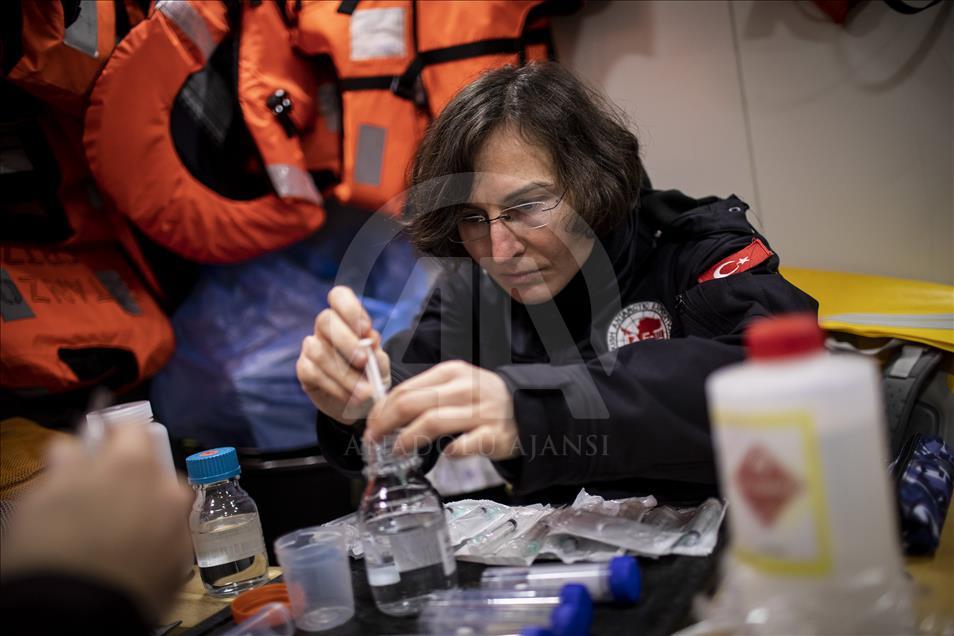
ANTARCTICA - FEBRUARY 03 : Sevil Deniz Yakan Dundar, Asst. Prof. Dr. at ITU Faculty of Naval Architecture and Ocean Engineering, Shipbuilding and Ocean Engineering inspects the stool samples after they were brought to a lab inside a ship in Antarctica on February 03, 2019. Turkish scientific research team members collected stool samples to identify the nutritional network in the focal organisms. Turkish scientific research team began their journey within the 3rd National Science Antarctica Expedition, under the auspices of Presidency of Turkey and under the coordination of the Ministry of Industry and Technology and Istanbul Technical University (ITU) Polar Research Center (PolReC). Scientists carry out studies in different fields such as polar biodiversity, living sciences, ecology and marine sciences at the white continent. ( Özge Elif Kızıl - Anadolu Agency )
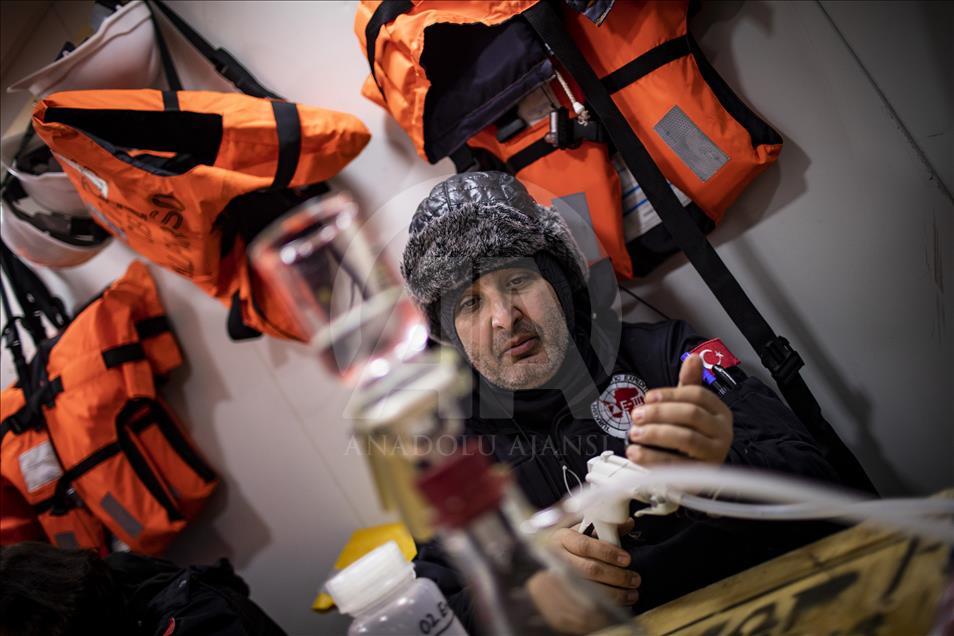
ANTARCTICA - FEBRUARY 03 : Ersan Basar, Assistant team leader and faculty member of Karadeniz Technical University's Maritime Transportation and Management Engineering Department inspects the stool samples after they were brought to a lab inside a ship in Antarctica on February 03, 2019. Turkish scientific research team members collected stool samples to identify the nutritional network in the focal organisms. Turkish scientific research team began their journey within the 3rd National Science Antarctica Expedition, under the auspices of Presidency of Turkey and under the coordination of the Ministry of Industry and Technology and Istanbul Technical University (ITU) Polar Research Center (PolReC). Scientists carry out studies in different fields such as polar biodiversity, living sciences, ecology and marine sciences at the white continent. ( Özge Elif Kızıl - Anadolu Agency )
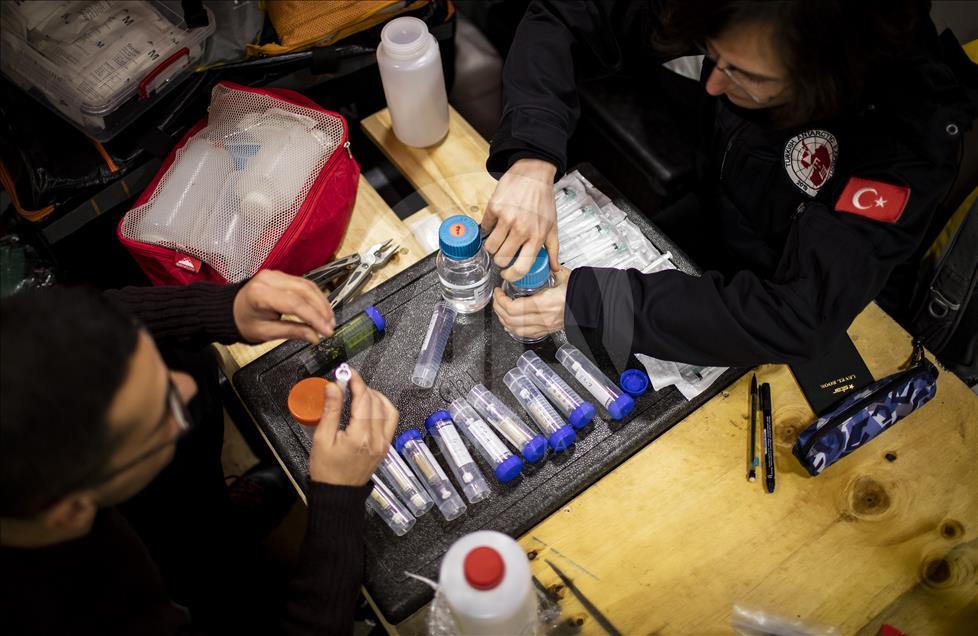
ANTARCTICA - FEBRUARY 03 : Sevil Deniz Yakan Dundar (R), Asst. Prof. Dr. at ITU Faculty of Naval Architecture and Ocean Engineering, Shipbuilding and Ocean Engineering and Selahattin Unsal Karhan (L), a marine biologist inspect the stool samples after they were brought to a lab inside a ship in Antarctica on February 03, 2019. Turkish scientific research team members collected stool samples to identify the nutritional network in the focal organisms. Turkish scientific research team began their journey within the 3rd National Science Antarctica Expedition, under the auspices of Presidency of Turkey and under the coordination of the Ministry of Industry and Technology and Istanbul Technical University (ITU) Polar Research Center (PolReC). Scientists carry out studies in different fields such as polar biodiversity, living sciences, ecology and marine sciences at the white continent. ( Özge Elif Kızıl - Anadolu Agency )

ANTARCTICA - FEBRUARY 07 : Korhan Ozkan, a faculty member of the METU Institute of Marine Sciences, inspects a tube containing collected stool samples at a lab inside a ship in Antarctica on February 7, 2019. Turkish scientific research team members collected stool samples to identify the nutritional network in the focal organisms. Turkish scientific research team began their journey within the 3rd National Science Antarctica Expedition, under the auspices of Presidency of Turkey and under the coordination of the Ministry of Industry and Technology and Istanbul Technical University (ITU) Polar Research Center (PolReC). Scientists carry out studies in different fields such as polar biodiversity, living sciences, ecology and marine sciences at the white continent. ( Özge Elif Kızıl - Anadolu Agency )

ANTARCTICA - FEBRUARY 03 : Selahattin Unsal Karhan, a marine biologist inspects the stool samples after they were brought to a lab inside a ship in Antarctica on February 03, 2019. Turkish scientific research team members collected stool samples to identify the nutritional network in the focal organisms. Turkish scientific research team began their journey within the 3rd National Science Antarctica Expedition, under the auspices of Presidency of Turkey and under the coordination of the Ministry of Industry and Technology and Istanbul Technical University (ITU) Polar Research Center (PolReC). Scientists carry out studies in different fields such as polar biodiversity, living sciences, ecology and marine sciences at the white continent. ( Özge Elif Kızıl - Anadolu Agency )

ANTARCTICA - FEBRUARY 07 : Korhan Ozkan (L), a faculty member of the METU Institute of Marine Sciences, inspects collected stool samples at a lab inside a ship in Antarctica on February 7, 2019. Turkish scientific research team members collected stool samples to identify the nutritional network in the focal organisms. Turkish scientific research team began their journey within the 3rd National Science Antarctica Expedition, under the auspices of Presidency of Turkey and under the coordination of the Ministry of Industry and Technology and Istanbul Technical University (ITU) Polar Research Center (PolReC). Scientists carry out studies in different fields such as polar biodiversity, living sciences, ecology and marine sciences at the white continent. ( Özge Elif Kızıl - Anadolu Agency )

ANTARCTICA - FEBRUARY 05 : Korhan Ozkan, a faculty member of the METU Institute of Marine Sciences, collects stool samples from the penguin colonies on Ardley Island in Antarctica on February 5, 2019, where they came to identify the nutritional network in the focal organisms. Turkish scientific research team began their journey within the 3rd National Science Antarctica Expedition, under the auspices of Presidency of Turkey and under the coordination of the Ministry of Industry and Technology and Istanbul Technical University (ITU) Polar Research Center (PolReC). Scientists carry out studies in different fields such as polar biodiversity, living sciences, ecology and marine sciences at the white continent. ( Özge Elif Kızıl - Anadolu Agency )

ANTARCTICA - FEBRUARY 06 : Korhan Ozkan, a faculty member of the METU Institute of Marine Sciences, arrives to collect stool samples from the seal colonies on Ardley Island in Antarctica on February 6, 2019, where they came to identify the nutritional network in the focal organisms. Turkish scientific research team began their journey within the 3rd National Science Antarctica Expedition, under the auspices of Presidency of Turkey and under the coordination of the Ministry of Industry and Technology and Istanbul Technical University (ITU) Polar Research Center (PolReC). Scientists carry out studies in different fields such as polar biodiversity, living sciences, ecology and marine sciences at the white continent. ( Özge Elif Kızıl - Anadolu Agency )

ANTARCTICA - FEBRUARY 05 : Tubes containing stool samples collected from the penguin colonies lie between rocks on Ardley Island in Antarctica on February 5, 2019, where they came to identify the nutritional network in the focal organisms. Turkish scientific research team began their journey within the 3rd National Science Antarctica Expedition, under the auspices of Presidency of Turkey and under the coordination of the Ministry of Industry and Technology and Istanbul Technical University (ITU) Polar Research Center (PolReC). Scientists carry out studies in different fields such as polar biodiversity, living sciences, ecology and marine sciences at the white continent. ( Özge Elif Kızıl - Anadolu Agency )
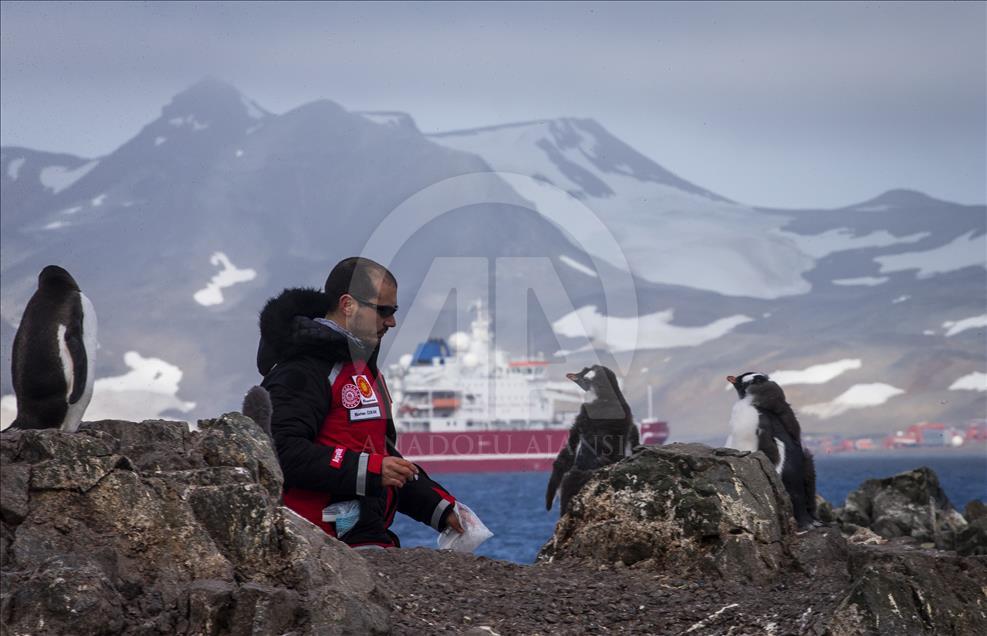
ANTARCTICA - FEBRUARY 05 : Korhan Ozkan, a faculty member of the METU Institute of Marine Sciences, collects stool samples from the penguin colonies on Ardley Island in Antarctica on February 5, 2019, where they came to identify the nutritional network in the focal organisms. Turkish scientific research team began their journey within the 3rd National Science Antarctica Expedition, under the auspices of Presidency of Turkey and under the coordination of the Ministry of Industry and Technology and Istanbul Technical University (ITU) Polar Research Center (PolReC). Scientists carry out studies in different fields such as polar biodiversity, living sciences, ecology and marine sciences at the white continent. ( Özge Elif Kızıl - Anadolu Agency )
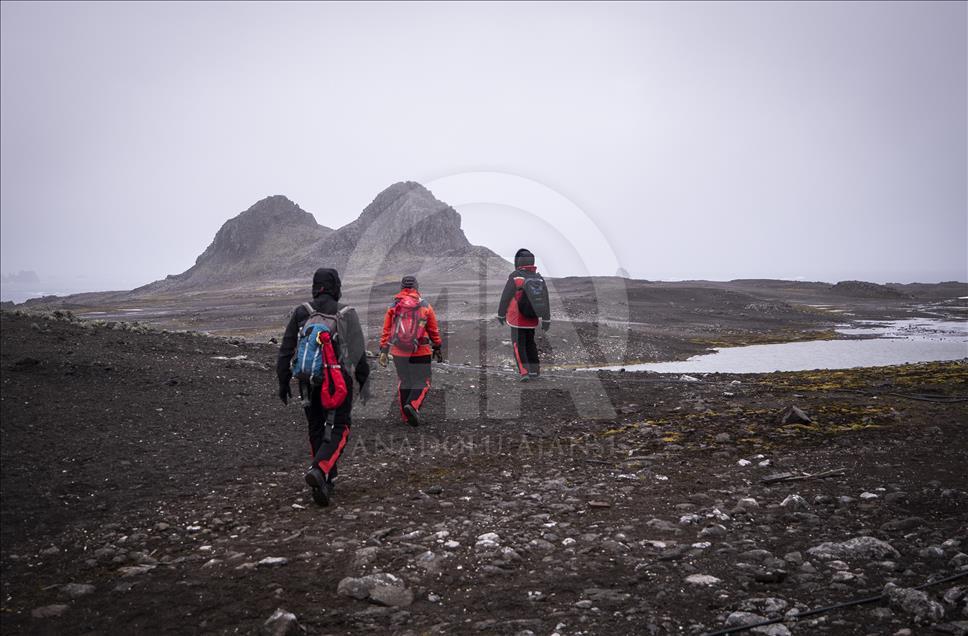
ANTARCTICA - FEBRUARY 06 : Korhan Ozkan (L), a faculty member of the METU Institute of Marine Sciences, and his colleagues make their way to King George Island in Antarctica on February 6, 2019, to collect stool samples from the seal colonies to identify the nutritional network in the focal organisms. Turkish scientific research team began their journey within the 3rd National Science Antarctica Expedition, under the auspices of Presidency of Turkey and under the coordination of the Ministry of Industry and Technology and Istanbul Technical University (ITU) Polar Research Center (PolReC). Scientists carry out studies in different fields such as polar biodiversity, living sciences, ecology and marine sciences at the white continent. ( Özge Elif Kızıl - Anadolu Agency )
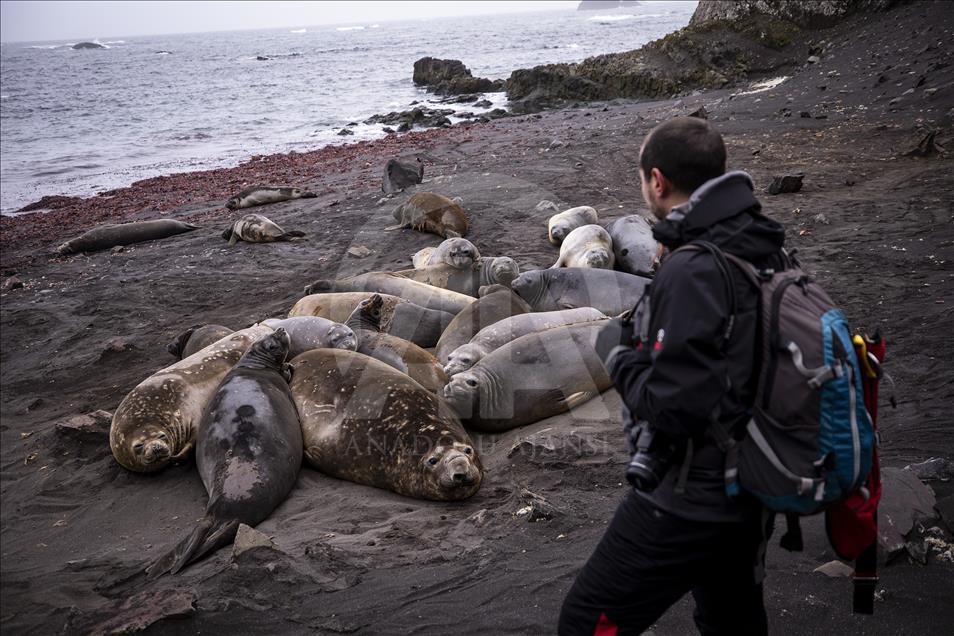
ANTARCTICA - FEBRUARY 06 : Korhan Ozkan, a faculty member of the METU Institute of Marine Sciences, arrices to collect stool samples from the seal colonies on Ardley Island in Antarctica on February 6, 2019, where they came to identify the nutritional network in the focal organisms. Turkish scientific research team began their journey within the 3rd National Science Antarctica Expedition, under the auspices of Presidency of Turkey and under the coordination of the Ministry of Industry and Technology and Istanbul Technical University (ITU) Polar Research Center (PolReC). Scientists carry out studies in different fields such as polar biodiversity, living sciences, ecology and marine sciences at the white continent. ( Özge Elif Kızıl - Anadolu Agency )
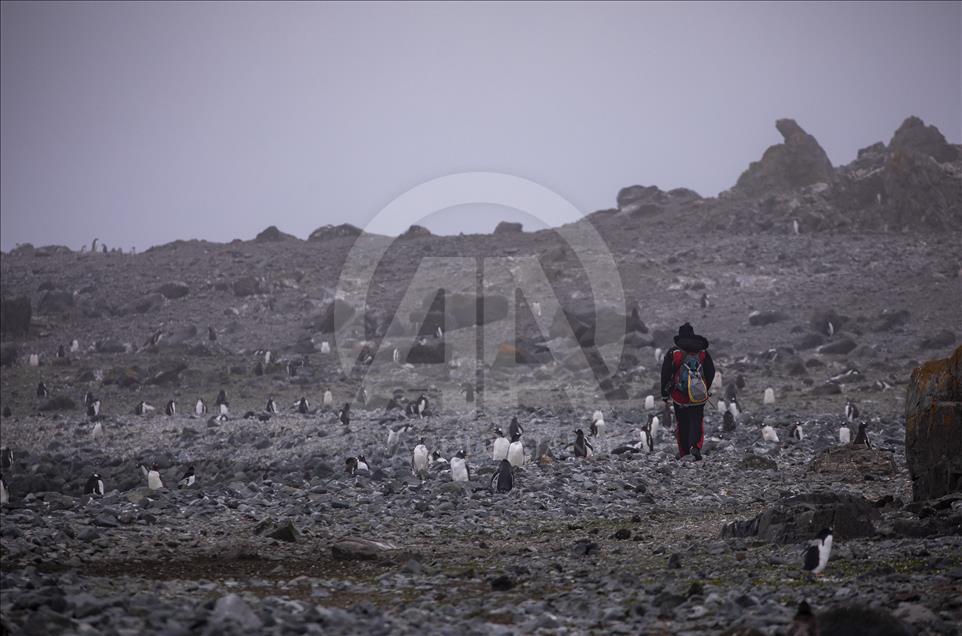
ANTARCTICA - FEBRUARY 05 : Korhan Ozkan, a faculty member of the METU Institute of Marine Sciences, collects stool samples from the penguin colonies on Ardley Island in Antarctica on February 5, 2019, where they came to identify the nutritional network in the focal organisms. Turkish scientific research team began their journey within the 3rd National Science Antarctica Expedition, under the auspices of Presidency of Turkey and under the coordination of the Ministry of Industry and Technology and Istanbul Technical University (ITU) Polar Research Center (PolReC). Scientists carry out studies in different fields such as polar biodiversity, living sciences, ecology and marine sciences at the white continent. ( Özge Elif Kızıl - Anadolu Agency )
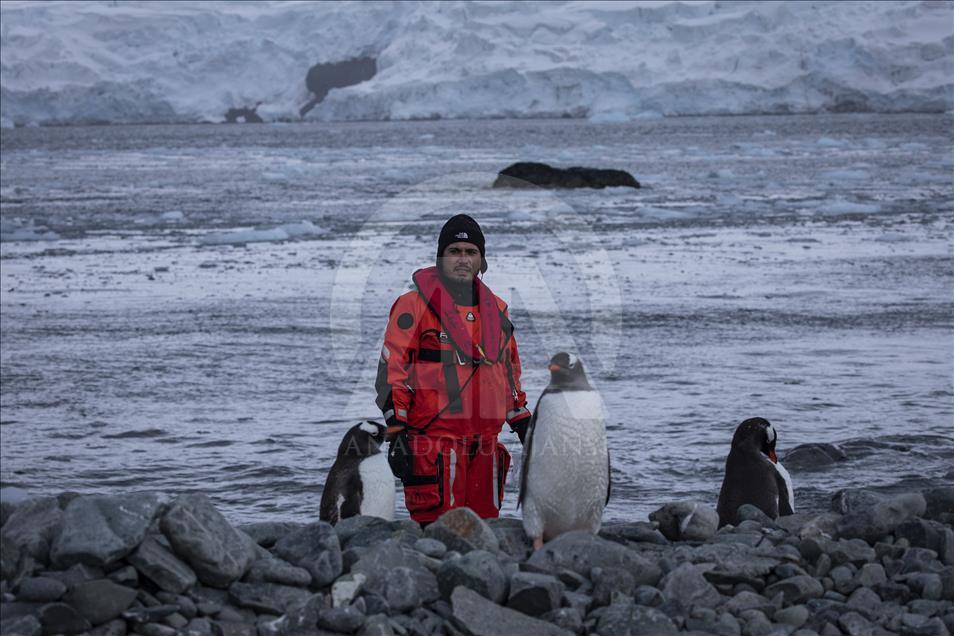
ANTARCTICA - FEBRUARY 07 : Korhan Ozkan, a faculty member of the METU Institute of Marine Sciences, collects stool samples from the penguin colonies near Bulgaria's St. Kliment Ohridski Base at Livingston Island, an Antarctic island in the South Shetland Islands, Western Antarctica lying between Greenwich Island and Snow Islands, on February 07, 2019 where they came to identify the nutritional network in the focal organisms. Turkish scientific research team began their journey within the 3rd National Science Antarctica Expedition, under the auspices of Presidency of Turkey and under the coordination of the Ministry of Industry and Technology and Istanbul Technical University (ITU) Polar Research Center (PolReC). Scientists carry out studies in different fields such as polar biodiversity, living sciences, ecology and marine sciences at the white continent. ( Özge Elif Kızıl - Anadolu Agency )

ANTARCTICA - FEBRUARY 03 : Ersan Basar, Assistant team leader and faculty member of Karadeniz Technical University's Maritime Transportation and Management Engineering Department inspects the stool samples after they were brought to a lab inside a ship in Antarctica on February 03, 2019. Turkish scientific research team members collected stool samples to identify the nutritional network in the focal organisms. Turkish scientific research team began their journey within the 3rd National Science Antarctica Expedition, under the auspices of Presidency of Turkey and under the coordination of the Ministry of Industry and Technology and Istanbul Technical University (ITU) Polar Research Center (PolReC). Scientists carry out studies in different fields such as polar biodiversity, living sciences, ecology and marine sciences at the white continent. ( Özge Elif Kızıl - Anadolu Agency )

ANTARCTICA - FEBRUARY 05 : Korhan Ozkan, a faculty member of the METU Institute of Marine Sciences, collects stool samples from the penguin colonies on Ardley Island in Antarctica on February 5, 2019, where they came to identify the nutritional network in the focal organisms. Turkish scientific research team began their journey within the 3rd National Science Antarctica Expedition, under the auspices of Presidency of Turkey and under the coordination of the Ministry of Industry and Technology and Istanbul Technical University (ITU) Polar Research Center (PolReC). Scientists carry out studies in different fields such as polar biodiversity, living sciences, ecology and marine sciences at the white continent. ( Özge Elif Kızıl - Anadolu Agency )

ANTARCTICA - FEBRUARY 03 : Sevil Deniz Yakan Dundar, Asst. Prof. Dr. at ITU Faculty of Naval Architecture and Ocean Engineering, Shipbuilding and Ocean Engineering inspects the stool samples after they were brought to a lab inside a ship in Antarctica on February 03, 2019. Turkish scientific research team members collected stool samples to identify the nutritional network in the focal organisms. Turkish scientific research team began their journey within the 3rd National Science Antarctica Expedition, under the auspices of Presidency of Turkey and under the coordination of the Ministry of Industry and Technology and Istanbul Technical University (ITU) Polar Research Center (PolReC). Scientists carry out studies in different fields such as polar biodiversity, living sciences, ecology and marine sciences at the white continent. ( Özge Elif Kızıl - Anadolu Agency )
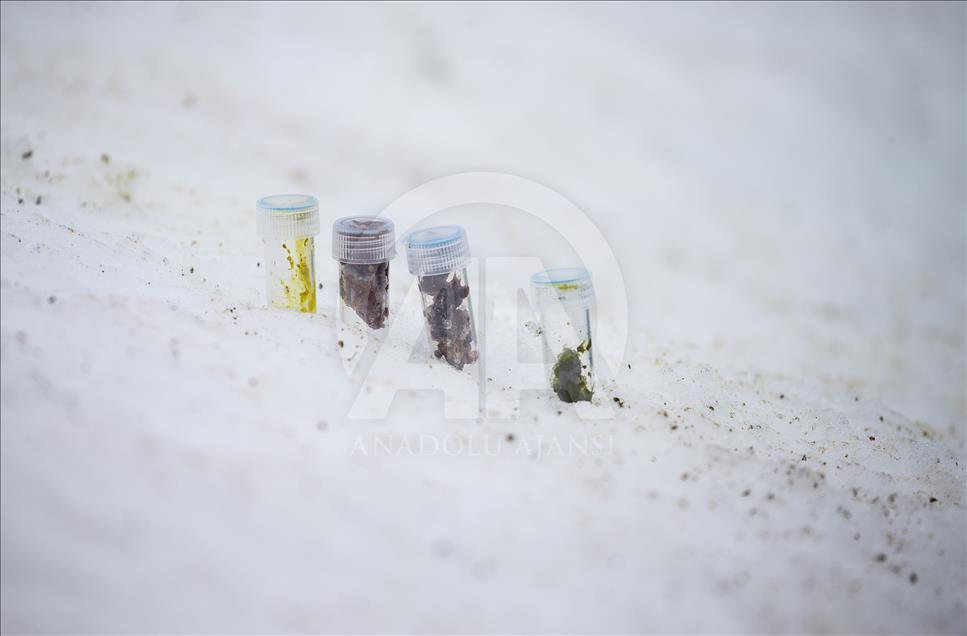
ANTARCTICA - FEBRUARY 05 : Tubes containing stool samples collected from the penguin colonies are seen stuck in snow on Ardley Island in Antarctica on February 5, 2019, where they came to identify the nutritional network in the focal organisms. Turkish scientific research team began their journey within the 3rd National Science Antarctica Expedition, under the auspices of Presidency of Turkey and under the coordination of the Ministry of Industry and Technology and Istanbul Technical University (ITU) Polar Research Center (PolReC). Scientists carry out studies in different fields such as polar biodiversity, living sciences, ecology and marine sciences at the white continent. ( Özge Elif Kızıl - Anadolu Agency )

ANTARCTICA - FEBRUARY 05 : Korhan Ozkan, a faculty member of the METU Institute of Marine Sciences, collects stool samples from the penguin colonies on Ardley Island in Antarctica on February 5, 2019, where they came to identify the nutritional network in the focal organisms. Turkish scientific research team began their journey within the 3rd National Science Antarctica Expedition, under the auspices of Presidency of Turkey and under the coordination of the Ministry of Industry and Technology and Istanbul Technical University (ITU) Polar Research Center (PolReC). Scientists carry out studies in different fields such as polar biodiversity, living sciences, ecology and marine sciences at the white continent. ( Özge Elif Kızıl - Anadolu Agency )










